——— A ———
A – (1) Abbreviation for ampere. (2) Abbreviation for the left channel of a stereo signal. Also called the L channel. See also R and B.
a – the symbol for absorption coefficient.
A2IM – American Association of Independent Music.
A2DP – Advanced Audio Distribution Profile. See Bluetooth profile.
A-3 – the low-bit-rate codec used by Dolby Labs for the Dolby Digital video format.
A440 – a method used to standardize the pitch of notes on the musical scale. Today the generally accepted pitch is defined as the note A above middle C being 440 Hz (cycles per second). Before the 19th century, there was no standardized musical pitch, and pitches varied from place to place and from time to time, with A having frequencies ranging from 373 Hz to 457 Hz. An early attempt at standardization occurred in 1713 when scientific pitch defined the frequencies of all the Cs as being powers of 2, with middle C being 256 Hz (28 Hz), which resulted in the A above middle C being approximately 430.54 Hz. It was not widely accepted.
The first widely accepted attempt at standardization occurred in 1859 when the French government passed a law that set A above middle C at 435 Hz. It was called the diapason normal and later known as French pitch, continental pitch, or international pitch. A conference in Vienna in 1885 adopted this standard for Italy, Austria, Hungary, Russia, Prussia, Saxony, Sweden, and Wuttemberg. Meanwhile, in Britain the Philharmonic Society set the philharmonic pitch as A being 452 Hz. It was was later replaced by a new philharmonic pitch in 1896 with A = 439 Hz. After 1896 in the UK, the term low pitch was used to refer to the new tuning standard of A = 439 Hz at 68°F, while high pitch was used for the old philharmonic pitch of A = 452 Hz.
The Stuttgart Conference of 1834 recommended C264 (A440) as the standard pitch based on studies by Scheibler. As a result, A440 was sometimes called the Stuttgart pitch or Scheibler pitch. In 1936, ANSI adopted the standard establishing 440 Hz for the pitch of A above Middle C, which became known as concert pitch. In 1955, the International Organization for Standardization (ISO) adopted this standard and reaffirmed it in 1975 as ISO 16. Sometimes designated as A=440 or A-440. Also called standard pitch, international standard pitch, or concert pitch.
.aa3 – file extension for the ATRAC format.
AAC – Advanced Audio Coding.
AAC-BSAC – Advanced Audio Coding - Bit-Sliced Arithmetic Coding. See bit-sliced arithmetic coding.
AAC-LC – Advanced Audio Coding - Low Complexity. See Advanced Audio Coding.
AAC-LD – Advanced Audio Coding - Low Delay. See Advanced Audio Coding.
aacPlus or aac+ – see High Efficiency Advanced Audio Encoding.
AAE – Avid Audio Engine. The underlying code designed by Avid that allows Pro Tools to communicate with computer hardware and software. Pro Tools is basically an user interface that tells the AAE (which runs in the background) what needs to be done. Prior to Pro Tools 11, the audio engine was the DAE (Digidesign Audio Engine), but beginning with PT 11 which upgraded to 64-bit, an all new audio engine was developed.
AAF – (1) Anti-Aliasing Filter (2) Advanced Authoring Format.
A and B rolls – the negative of an edited film, cut to correspond to a movie, consisting of two rolls, designated A and B, to allow for fades, dissolves, and other effects without using opticals. The A roll has all the odd numbered shots, with black leader in place of the shots on the B roll, while the B roll has all the even numbered shots, with black leader in place of the shots on the A roll. The negative is printed in three passes through the contact printer, one for each roll and another for the soundtrack. See also answer print.
AAX – Avid Audio eXtension. The plug-in format for Pro Tools 10 and above, which replaced RTAS and TDM used in earlier version of Pro Tools. AAX comes in two versions: AAX DSP (compatible only with Pro Tools|HDX systems) and AAX Native (compatible with both Pro Tools and Pro Tools|HD for PT 10 and above. TDM is not supported in Pro Tools|HDX. Pro Tools 11 and above requires the 64-bit version of AAX, sometimes referred to as AAX 2.
AAX 2 – slang for the 64-bit version of AAX.
AAX DSP – see AAX.
AAX Native – see AAX.
AB – abreviation for Audiobus.
A-B – the procedure for comparing the sound of two different audio sources, by first listening to one source (A) and then quickly switching to the second (B). For the best accuracy, both sources should be at the same level. See also ABX.
ABC – American Broadcasting Company or Australian Broadcasting Corporation.
A-B-C stereo, A/B/C stereo, or ABC stereo – see Decca tree.
Ableton AG – a music software company based in Berlin, Germany, that produces and distributes the software program Ableton Live, as well as a collection of related instruments and sample libraries. Ableton was founded in 1999 by Gerhard Behles, Robert Henke, and Bernd Roggendorf.
Ableton Link – a technology developed by Ableton that connects Link-enabled applications over a local network. It synchronizes the tempo and phase of music across multiple applications running on one or more devices. Applications on devices connected to a local network can discover each other automatically to form a musical session, with each participant performing independently. Any participant can join or leave without disrupting the session. If any participant changes the tempo, the others will follow automatically. Participants can start or stop while remaining in time.
Ableton Live – a software music sequencer and digital audio workstation developed by Ableton. Unlike many other software sequencers, Live is designed to be an instrument that can be used in live performances, as well as a tool for composing, recording, arranging, mixing, and mastering. It is also used by deejays, having controls for beatmatching, crossfading, and other effects.

Abbey Road Studios – a recording studio located at 3 Abbey Road, Westminster, a suburb of London, England. Abbey Road Studios is noted for its innovative recording techniques developed by its engineers in conjunction with the Beatles (who recorded most of their albums and singles there), Pink Floyd, the Hollies, and other bands during the 1960s. The building began as a nine-bedroom townhouse built in the 1830s, but was later converted to flats (apartments). In 1931, the building was purchased by the Gramophone Company who converted it into recording studios. The same year, the Gramophone Company merged with the Columbia Graphophone Company to form EMI and the facility was named EMI Studios. After the Beatles released their album entitled Abbey Road in September 1969, the studios received world-wide attention, and in 1970 the building was renamed Abbey Road Studios. In 2010, the British government granted it historical status, preventing it from being sold to real estate developers. In 2012, the studio became the property of Universal Music with its acquisition of EMI.
Abfusor™ – a trademark of RPG Diffusor Systems for a panel that has both absorption and diffusion properties.
A-B powering – an essentially obsolete method of providing power for condenser microphones, similar to phantom power, but using the signal leads (modulation leads). As such it is incompatible with normal phantom power and potentially harmful to dynamic and ribbon microphones. It is also called Tonader powering, T-powering, parallel powering, and modulation lead powering.
ABR – Average BitRate .
A-B recording – see A-B technique.
absolute grid mode – an editing mode in a DAW that allows movement and alignment of clips to specific points along a grid with user-defined increments. See also relative grid mode.
absolute measurement – the measurement of a quantitiy starting from zero or a known starting point. For example, the measurment of a voltage is the number of volts above zero volts, while the height of a building is the distance from street level (starting point) to the top of the building. In contract, a relative measurement is the measurement of a change in a quantity or in relation to another item or device. For example, the gain of an amplifier is the change in voltage from the input to output.
absolute phase – see absolute polarity.
absolute polarity – when the compressions and rarefactions of reproduced music are in sync with the compressions and rarefactions of the original performance. In other words, a positive force on the microphone diaphragm will produces a positive force on the speaker cone, which means there must not be any change in polarity from the microphone signal, through the preamp, recording medium, signal processors, reproduction devices, amplifiers, and speakers. Real life sound never has inverted polarity, it occurs only with reproduced sound. Many experts claim that inverted polarity sound introduces harsh sibilance, blurs preamptransients and fine details, and makes spoken words less intelligible. Sometime called by the less technically correct term absolute phase.
absolute pitch – the ability to identify or reproduce a musical note without using a reference pitch. Only 0.01% of people have this ability. Most people have relative pitch, the ability to determine if one pitch is higher or lower than another.
absolute time – the measure of elapsed time from the beginning of the tape, disc, or other media, usually measured in hours, minutes, seconds, and frames. Abbreviated as A-time.
absolute time in pregroove (ATIP) – a timecode reference signal in minutes, seconds, and frames used on CD-R, CD-RW, and other writable optical discs. The polycarbonate layer of a writable disc has a spiral pregroove that is created during the manufacturing process. The pregroove track is used to guide the read/write laser during writing in order to maintain accurate spacing between tracks. The spiral has a slight sinusoidal deviation from a perfect spiral, and the frequency of this sine curve is called the wobble frequency. The wobble frequency is used to synchronize the rotation speed of the disc to maintain an accurate linear velocity (the speed of the track as it passes the laser). The wobble is also modulated with a timecode reference signal, the ATIP.
absolute time code (ATC) – a timecode recorded in the subcode or control track of a digital tape. Almost all digital tape machines record it automatically. ATC is used to perform a variety of functions on digital tape such as autolocation, which locates specific points on a tape, and to synchronize the tape to other equipment. ATC usually can be converted to SMPTE timecode, but unlike SMPTE timecode, ATC always begins at zero at the beginning of a digital tape and increments frame by frame until recording stops.
absorb – to take in a sound wave rather than passing it through or reflecting it.
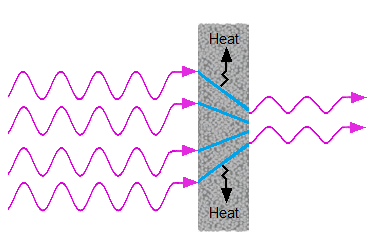
absorber – a material that attenuates sound by taking in sound waves, where most of the sound energy is converted to heat. There are three main types of absorbers: resonant absorbers, pressure absorbers, and velocity absorbers. Resonant absorbers (resonators) use a resonance mechanism such as an enclosed air volume to absorb sound energy of a specific range of frequencies. Materials that act primarily on sound pressure are called membrane absorbers, panel absorbers, or pressure absorbers. They affect frequencies mainly below 125 Hz. Materials that act primarily on sound velocity are called porous absorbers, resistive absorbers, or velocity absorbers and act primarily on frequencies above 125 Hz. Membrane absorbers, which have a resonance mechanism (vibrating surface), are sometimes grouped with resonant absorbers. Also called sound-absorbent material or sound-absorption material. See also acoustic treatment.
absorber panel – see panel absorber.
absorption – the process of taking in a sound wave rather than passing it through or reflecting it. Sometimes called acoustic absorption. See also absorber and acoustic treatment.
absorption coefficient (a) – the ability of a material to absorb sound waves at a particular frequency, with a higher coefficient indicating better acoustical damping. Sometimes called a sound absorption coefficient and abbreviated SAC.
absorption loss – the decrease in signal strength that occurs when a radio wave transmitted by a wireless microphone passes through a material that absorbs some of the RF energy. See also transmission loss.
absorption panel – see panel absorber.
absorption wave meter – an instrument used for determining audio frequencies or radio frequenciess, consisting of a calibrated tunable circuit and a resonance indicator.
absorptive silencer – see silencer.
A/B switch – a switch with one input and two outputs (A and B) or one output and two inputs (A and B), which allows the user manually to select between two inputs or outputs. For example, it can be used to select between two sets of studio monitors or to connect two devices to one computer. Also called an AB switch, A-B switch, A/B box, AB box , A-B box, A/B switch box, AB switch box, or A-B switch box. See also A/B/Y switch.
A-B stereo – see A-B technique.
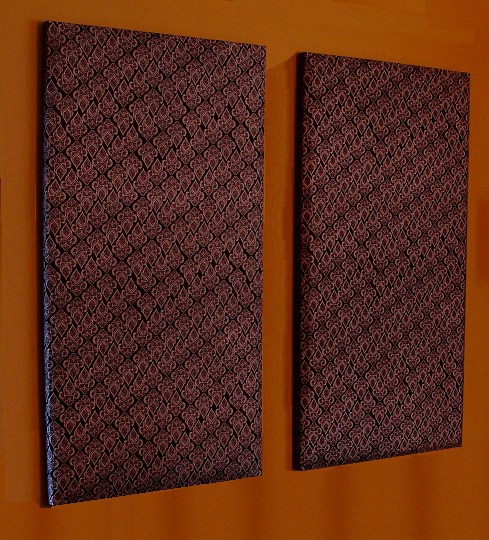
A-B technique – a stereo microphone technique using two omnidirectional microphones facing forward and anywhere from 12 inches (30 cm) to 48 inches (122 cm) apart. Therefore, it can be categorized as both a near-coincident pair and a spaced pair. Also called A-B recording or A-B stereo. Sometimes written as AB or A/B. See also coincident pair, ORTF, DIN, NOS, EBS, RAI, Blumlein array, Faulkner array, Decca tree, mid-side, and X-Y pair. See also table comparing various stereo microphone techniques.
ABX testing – a type of double-blind testing in which a subject hears audio sample A, then audio sample B, followed by audio sample X. The subject must determine whether X is A or B. It is a double-blind test because neither the tester nor the subject knows which source is A, B, or X. Also called ABY testing or double-blind comparator. See also A-B.
ABY – see ABX testing.
A/B/Y switch – a switch that allows for the selection between two signals (A or B) or both (A and B, equivalent to a Y connection). Also called an ABY switch or A-B-Y switch. See also A/B switch
ac – alternating current. Although officially written in lower case, it is frequently shown as AC.
AC-1 – Audio Codec 1. Dolby Lab's first development of a digital audio coding scheme, adopted in 1984. It uses ADPCM, and it is still in use today by some satellite and cable providers. AC-1 has a data rate between 220 kbps and 325 kbps.
AC-2 – Audio Codec 2. A digital audio coding scheme developed by Dolby Labs that incorporates a perceptual coding algorithm to create a low-bit-rate high-quality signal, that substantially reduces the data capacity required for cable, satellite, and digital audio applications. It uses a data rate of 128 kbps or 192 kbps.
AC-3 – Audio Codec 3. See Dolby Digital.
ACA – (1) Active Combining Amplifier. See combining amplifier (2) Avid Customers Association.
AC adapter – see power adapter.

Academy curve – an equalization curve adopted by the Academy of Motion Picture Arts and Sciences in 1938 to be used on standard movie optical tracks. The response is flat between 100 Hz and 1.6 kHz, down 7dB at 40Hz, down 10 dB at 5 kHz, and down 18 dB at 8 kHz. The severe reduction of the high end was designed to hide the high-frequency crackling noise inherent in early film sound production. Also called the N curve (for normal) or academy sound. See also X curve.
Academy leader – a film leader with the standard visual countdown preceding a movie, counting down from 10 to 3. It is used for alignment and timing purposes, including the start of the first reel and for the change-over from one reel to the next during projection. Named after the Academy of Motion Picture Arts and Sciences, which establishes motion picture standards. In the 1960s, the SMPTE leader was introduced for use by theaters and television..
Academy of Motion Picture Arts and Sciences (AMPAS) – a professional honorary association formed for the advancement of the movie industry, composed of more than 6,000 motion picture professionals. The Academy is probably best known for its annual presentation of the Academy Awards, now officially known as “The Oscars.”
a cappella – music that consists only of one or more voices, without any instrumental accompaniment.
ACB – Analog Circuit Behavior. A technique developed by Roland that seeks to emulate the behavior of the components (resistors, capacitors, etc.) in an analog circuit in order to reproduce the sound created using that analog circuit. This technology is used in their keyboard and synthesizer products.
ac bias – see tape bias.
accelerando (accel.) – a musical term indicating that the tempo should be gradually increased. The opposite of ritardando.
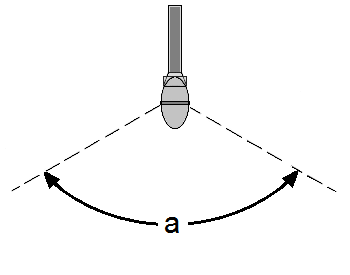
accent – (1) In music, emphasis placed on a note or chord by an increased in volume or a longer duration. (2) A mark used in music to indicate a stressed or emphasized note.
accent microphone – see spot microphone.
accent miking – see spot miking.
acceptance angle – the angle between the points on a microphone polar response curve where the level of a sound source is a specified number of decibels (usually 3 or 6 dB) lower than the on-axis level, which defines the useful working area (coverage area) of the microphone. An omnidirectional microphone has an acceptance angle of 360°, a cardiod microphone 131°, a supercardiod microphone 115°, a hypercardiod microphone 105° and a bidirectional microphone (figure-8) 90°. Also called an coverage angle or pickup angle.
access jack – either two separate 2-conductor jacks or one 3-conductor jack on a mixer that allow the signal to be routed from the input channel to an outboard processor and then return back to the input channel. Inserting a plug into the access jacks breaks the signal flow and inserts a signal processor in series with the signal. Also called an insert jack. See also insert, definitions #2 and #3, and insert cable.

accidental – a music symbol used to alter the pitch of a note, such as a sharp (♯), flat (♭), or natural (♮).
accompaniment – a vocal or instrumental part that supports and enhances another musical part, often a solo. For example, a piano is often used to provide an accompaniment for a solo singer or an instrument such as a violin.
accordion – a hand-held musical instrument that produces sound by air passing over metal reeds blown by bellows that are squeezed by the player. Notes are played by means of keys and buttons. There are three basic types of accordions: (a) the piano accordion, (b) the chromatic accordion, and (c) the diatonic accordion. The piano accordion, the type most familiar to Americans, has a piano-style keyboard for the right hand and an array of buttons for bass accompaniment for the left hand. A full-size piano accordion has 41 treble keys and 120 to 140 bass buttons. Chromatic accordions, more common in Europe, have buttons for both hands, treble for the right hand and bass for the left hand. Diatonic accordions (also known as melodeons) have buttons for both hands, but are pitched in a single key.
ac erasure – see erase.
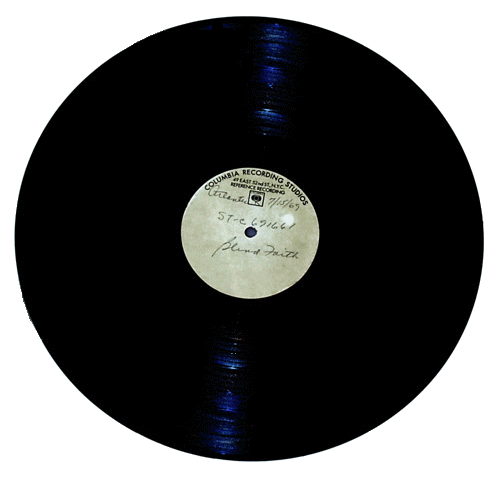
acetate – a type of phonograph record widely used from the 1930s through the 1950s for recording and broadcast purposes and still used occasionally today. An acetate blank consists of an aluminum disc coated with nitrocellulose lacquer—not acetate. An acetate record is created using a recording lathe to cut a sound-modulated groove into the surface of the blank disc. An acetate master can be electroplated to create a stamper, which is used to press large quantities of regular vinyl records. Acetates also have been used for testing the quality of a tape-to-disc transfers, for comparing different takes or mixes, or for providing early preview copies of new singles to influential radio station disc jockeys. Although they can be played on a normal phonograph, they are much more susceptible to rapid wear than a vinyl record. Since they are usually created for special purposes and almost never sold to the general public, some acetates are highly prized because of their rarity. Also called an acetate disc, a test acetate, a lacquer (technically correct and preferred by the recording industry), a transcription disc, and an instantaneous disc.
acetate disc – see acetate.
acetate film – a film made of cellulose acetate. It is used both for the material for motion picture film (having replaced the very unstable cellulose nitrate) and as the base for magnetic recording tape. Polyester has largely supplanted acetate as the preferred medium in recording tape because of its superior stability and tensile strength.
A-chain – the section of movie sound reproduction systems in theaters that consists of a sound transducer (optical track reader or digital decoder), preamplifier, noise reduction, and matrix decoding, if applicable. After the A-chain decodes the sound files, the audio is sent to the the B-chain and the loudspeakers. See also digital cinema package.
acicular – shaped like a needle. In audio this term is most commonly applied to magnetic particles used in recording tape. Acicular particles have a higher particle density and better particle orientation than cubic particles, resulting in higher coercivity and retentivity., which provides improved gain and dynamic range.
ACIP – Audio Contribution over IP. See Audio over IP.
ACM – Audio Compression Manager.
ACO – Alliance of Composer Organisations. See British Academy of Songwriters, Composers, and Authors.
acoustic – (1) Pertaining to sound audible by the human ear or the sense of hearing. (2) Pertaining to a musical instruments without electrical amplification, such as an acoustic guitar. (3) Pertaining to musicians playing musical instruments without electrical amplification. (4) The properties or qualities of a room that determine how sound is transmitted within it. (5) A musical instrument without electrical amplification. (6) Referring to the acoustic recording method.
acoustic absorption – see absorption.
acoustical – a variation of the term acoustic.
acoustical engineer – an engineer that works with sound and vibration and the applications of acoustics. Acoustical engineers typically deals with the design, analysis, and control of sound. Also called an acoustic engineer.
Acoustical Society of America (ASA) – a standards organization founded in 1929 to establish standards for acoustics and vibrations.
acoustical tile – see acoustic tile.
acoustic amplifier – (1) The part of an instrument that intensifies the sound emanating from it. For example, the body of a violin or acoustic guitar. (2) A device that amplifies sound without using electricity, such as an acoustic horn.
acoustic analysis – see spectrum analysis.
acoustic anechoic chamber – see anechoic chamber.
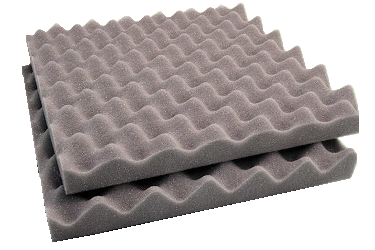
acoustic barrier – a material or a design used for soundproofing.
acoustic bass – see double bass.
acoustic blanket – see sound blanket.
acoustic drums – see acoustic percussion.
acoustic echo chamber – see echo chamber.
acoustic-electric guitar – an acoustic guitar equipped with a pickup to amplify of the guitar signal. Often a piezo pickup is used, but sometimes a hybrid system is used that blends the signal from both a piezo pickup and an internal microphone. Also called an electro-acoustic guitar.
acoustic engineer – see acoustical engineer.
acoustic era – the portion of recorded music history from about 1890 to 1925. During this period, records were produced using the acoustic recording method. In 1925, the electrical era began with the advent of using electrically-amplified microphone signals to make recordings. Also called acoustic recording era.
acoustic feedback – see feedback.
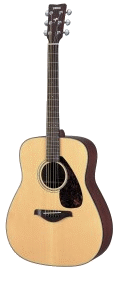
acoustic foam – a specially designed open-celled foam used to absorb sound waves.
acoustic gain – the amount of amplification provided by a public address (PA) system. See also needed acoustic gain.
acoustic guitar – an ordinary guitar, which produces sound through its soundboard, as opposed to an electric guitar, whose sound is amplified by electronic means. Although some acoustic guitars have jacks that allow attachment to an amplifier, they are still considered acoustic because they produce sound in the normal manner in the absence of an amplifier.
acoustic horn – a cone-shaped device used to maximize the transfer of sound into air without the use of electronics. Acoustic horns can work in either direction, both increasing the intensity of a sound or being used at the receiving end to optimize the transfer of sound from the air to a receiver, such as used in early recordings. Acoustic horns have many applications, including phonograph horns, megaphones, vehicle horns, ear horns (for the hard of hearing), and horn-loaded loudspeakers.
acoustician – a scientist who specializes in acoustics. The term is sometimes used to include acoustical engineers.
acoustic impedance – the measure of the opposition that a system presents to acoustic flow from a sound pressure applied to the system, somewhat analogous to electrical impedance. Acoustic impedance consists of acoustic resistance (the real component) and acoustic reactance (the imaginary component). The acoustic impedance (Z) of a given material is calculated as Z = p × V, where p is the density of the material and V is the acoustic velocity.
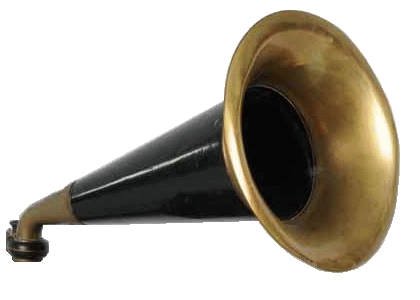
For a Phonograph
acoustic instrument – an instrument whose sound is not amplified by electronic means, such as an acoustic guitar. See also electric instrument.
acoustic insulation – see soundproofing.
acoustic intensity – see sound intensity.
acoustic intensity level – see sound intensity level.
acoustic interference – see interference, definition #1.
acoustic isolation – see soundproofing.
acoustic labyrinth – (1) Folded pathways used in the body of some highly directional microphones designed to maximize the rejection of off-axis sounds. Those sounds arriving on-axis reach the capsule in-phase, while off-axis sounds, traveling longer and varied pathways, reach the diaphragm somewhat out-of-phase and are partially or fully removed by phase cancellation. (2) A type of speaker enclosure in which sound waves from the woofer travel through a long, folded pathway before reaching the exit, which greatly extends bass response.
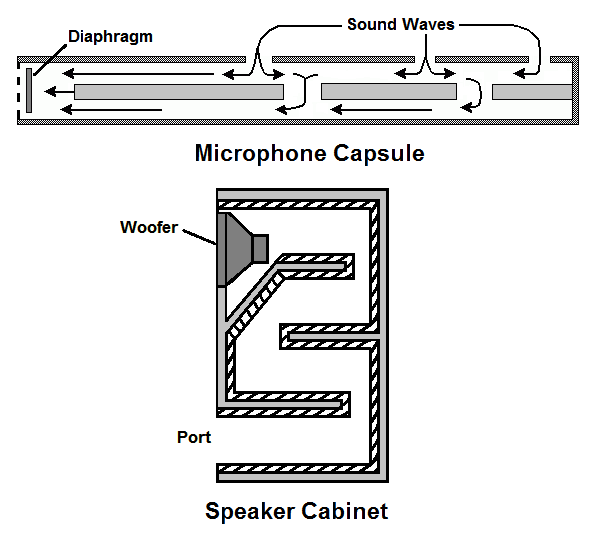
acoustic lens – a mechanism used to improve the dispersion of high frequencies in loudspeakers creating a more uniform dispersion across the audio spectrum. Developed by Bell Laboratories during World War II, the objective of the acoustic lens is to focus sound just as an optical lens focuses light.
acoustic load – the additional stiffness on a loudspeaker caused by the volume of air in the enclosure. For low frequencies, this additional stiffness can be four times the stiffness of the speaker cone. The increased internal air stiffness is caused by the walls of the enclosure imposing zero airspeed on the air within the enclosure.
acoustic ohm – a unit used to measure acoustic impedance, analogous to the electrical ohm.
acoustic panel – see panel absorber.
acoustic percussion – a term used to distingush actual percussion instruments that are played by striking with a hand, stick, or beater, or by shaking, from electronic or programmed percussion instruments. Included in this group are acoustic drums.
acoustic phase interference – see phase cancellation.
acoustic piano – a term used to describe a regular piano that produces sound using the purely natural acoustics of felt-covered hammers hitting steel wire strings, as opposed to an electric piano, an electronic piano, or a digital piano, which use electronics to produce their sound.
acoustic power – see sound power.
acoustic power level – see sound power level.
acoustic power output – see power output.
acoustic pressure – see sound pressure.
acoustic pressure level – see sound pressure level.
acoustic quieting – the process of damping vibrations from equipment to reduce the level reaching a listener.
acoustic radiator – a surface that when vibrated produces sound waves, such as a loudspeaker cone or a headphone diaphragm.
acoustic resistance – see acoustic impedance.
acoustic reactance – see acoustic impedance.
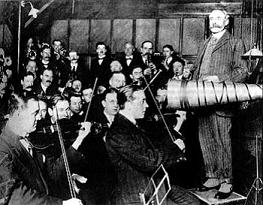
acoustic recording – the method of recording in use during the acoustic era, from the time of Thomas Edison until the advent of electrical recordings in 1925. With this technique, all the energy used to create a recording came only from sound waves, with no electrical enhancements. Sound was collected using an acoustic horn with an attached stylus that transferred the sound vibration onto the surface of a cylinder or disc. Because there were no volume controls, mixing was done by arranging the singers and musicians in such a way to provide the best blend for the recording. Also called mechanical recording.
acoustic recording era – see acoustic era.
acoustic reflection – see reflection.
Acoustic Research – a high-end audio equipment company based in Cambridge, Massachusetts, that was well-known for its line of acoustic suspension loudspeakers. AR was the first company to produce loudspeakers with a flat response, extended bass, wide dispersion, small size, and at a reasonable cost. The brand is now owned by VOXX International.
acoustics – (1) The science or study of the properties of sound and sound propagation. (2) The manner in which sound behaves in an enclosed space, more precisely called room acoustics. See also acoustic theory, architectural acoustics, and psychoacoustics.
acoustic scattering – see diffusion.
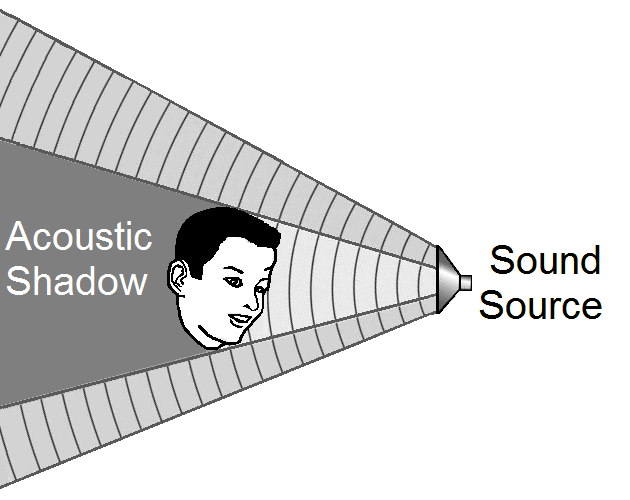
acoustic screen – see gobo.
acoustic shadow – an area in which sound waves are greatly reduced, due obstructions, such as walls, or disruptions, such as wind currents. It is analogous to a shadow caused by the obstruction of light. See also head shadow.
acoustic signal – a sound wave represented as an audio signal, either as an analog signal or a digital signal.
acoustics modelling – see room acoustics simulation.
acoustic space – the environment in which sound is heard, characterized by the interaction between sound and the space as absorption, reflection, or diffraction by the walls. Sometimes called acoustic environment. See also architectural acoustics.
acoustic squeak – see string squeak.
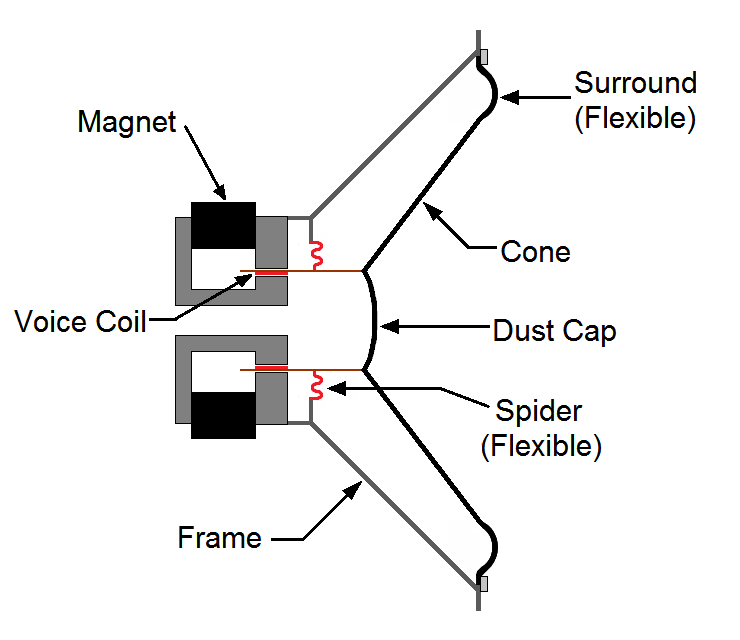
Speaker Diagram
acoustic suspension – a type of loudspeaker developed by Acoustic Research (AR) in which the speaker cone is attached to the mounting ring with an elastic material in a sealed enclosure. Unlike a conventional speaker with a stiff suspension, the air trapped inside the sealed-enclosure provides a more linear restoration of the speaker diaphragm and allows greater cone excursions, producing deeper bass tones with relatively smaller cones. Unfortunately this design results in a less efficient speaker system requiring more amplifier power. Althougn acoustic suspension speakers were at one time extremely popular in stereo systems because of their low distortion, bass reflex speakers have become more common as the design of speakers with ported enclosures has improved.
acoustic theory – the study of acoustics using a mathematical description of sound waves as derived from fluid dynamics.
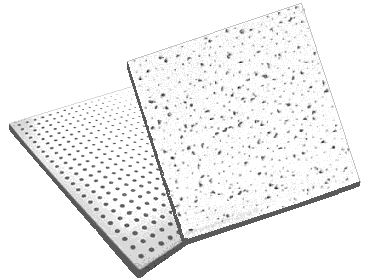
acoustic tile – a ceiling tile made of soft, sound-absorbing material, often having a pattern of small, regularly or irregularly spaced holes. Acoustic tiles can be hung using a ceiling suspension system, installed directly over an existing ceiling, or attached to a wall. The purpose is to dampen echoes and reverberations and reduce exterior noise. Acoustic tile is commonly used in churches, schools, theaters, and concert halls, but rarely in recording studios, which require more sophisticated acoustic treatments. Also called acoustical tile.
acoustic transmission line – a long duct that acts like an acoustic waveguide, used to produce or transmit sound with minimal distortion. It typically consists of a rigid-walled tube or pathway that is long relative to the wavelength of the sound passing through it. Named because it is acoustically analogous to an electrical transmission line.
acoustic treatment – various devices and methods used to control the sound properties (temporal, spectral, and spatial qualities) in a space. There are three main categories of acoustic treatment: (a) absorption, (b) diffusion, and (c) isolation. These treatments are used to control reflections and prevent sounds from interfering with one another, as well as to prevent sounds from entering or leaving the space (isolation). The goal of acoustic treatment is to have a space with an essentially flat response and with minimal coloration contributed by the room. Room problems are related to room dimensions (see room ratios), construction materials, and surface finishes. Acoustic problems are usually divided into two classes: (1) low frequency problems and (2) midrange and high-frequency problems. Low-frequency issues are related to standing waves (room modes) and are usually treated with bass traps, such as Helmholtz resonators and membrane absorbers. Higher-frequency problems are due to reflections that cause echoes and reverberations. These problems are typically treated using absorption and diffusion. In the absence of acoustic treatment, most spaces tend to accentuate some frequencies and attenuate others.
acoustic velocity – see particle velocity or velocity.
acoustic velocity level – see sound velocity level.
acoustic wave – see sound wave.
acquisition time – the time required for a sample-and-hold (S/H) process to acquire an analog value during an analog-to-digital conversion.
ac tape bias – see tape bias.
action – (1) On stringed instruments, such as a guitar, the distance between the fingerboard and the strings. When the strings are far above the fingerboard, it is called high action. When the strings are close to the fingerboard, it is called low action. Guitars with low action are easier to play, but if they are too close can cause fret buzz. (2) On keyboard instruments, the mechanism that causes a string to be struck or plucked when a key is depressed.
activate – see enable.
active – (1) Using amplifiers or external power sources in devices, such active monitors, active speakers, or active microphones. (2) Contributing and involved, such as an active component.
active balanced output – see balanced output.
active circuit – an electronic circuit that contains active components, such as transistors, vacuum tubes, or integrated circuits, which require a power source, as opposed to a passive circuit, which has no active components.
active combining Amplifier – see combining amplifier.
active combining network – see combining network.
active component – (1) A device that has the ability to amplify a signal or produce a gain in power. Active components increase power, voltage, or current and are powered by a source of electricity that is separate from the electrical signal. Examples of active components include transistors, vacuum tubes, and integrated circuits. Passive components include resistors and capacitors. (2) In a computer, things that require electrical power to operate, such as the power supply, fans, storage devices, transistors, and integrated circuits. Passive components include the chassis, capacitors, and enclosures.
active crossover – see crossover.
active filter – a filter that uses an amplifier, so that it can boost as well as cut a frequency range. Active filters can be constructed of smaller, less expensive components than passive filters. The disadvantage is that they require external power, require more parts, and introduce a small amount of noise.
active loudspeaker – a loudspeaker that has a built-in power amplifier and requires no external amplification. Compare with passive loudspeaker.
active microphone – see active ribbon microphone.
active monitor – a studio monitor that has a power amplifier built in and requires no external amplification. Compare with passive monitor.
active noise cancellation – see noise cancellation.
active noise control – see noise cancellation.
active noise reduction – see noise cancellation.
active ribbon microphone – a ribbon microphone with a built-in preamplifier. Because a standard passive ribbon microphone has a much lower output than other microphone types, it is convenient to use an active ribbon to boost the signal by 5 to 10 dB. Such microphones require phantom power to supply the preamp.
active sensing – a system used to verify that a MIDI connection is functioning, consisting of sending a signal to a MIDI device, and if no response is received within a specified period (typically 300 ms), all notes are switched off preventing notes from hanging when communication is lost. Active sensing is supported by only a few MIDI devices.
active speaker – see active loudspeaker.
actual sound – see diegetic sound.
acuity – the ability to hear very soft sounds or to distinguish the subtle qualities of a sound.
A-curve – see A-weighting.
A/D – Analog-to-Digital. See Analog-to-Digital conversion. Also written as AD, A-D, or A-to-D.
adagio – a musical term indicating a slow and leisurely tempo, typically 55 to 76 bpm. See chart of tempo terms.
adagietto – a musical term indicating a rather slow tempo, typically 65 to 76 bpm. See chart of tempo terms.
adagissimo – a musical term indicating a very slow and calm tempo, slower than adagio, typically 40 to 52 bpm. See chart of tempo terms.
ADAM® – Akai Digital Audio Multitrack. A 12-track digital audio recording system, developed by Akai, that used Video 8 tape. It recorded using 16 bits at a sampling rate of 44.1 kHz or 48 kHz. Sometimes written A-DAM.
ADAM Audio – a company founded in 1999 in Berlin, Germany, that designs and manufactures professional audio speakers and monitors. In 2019, ADAM was acquured by Focusrite.
adapter – (1) A connector that enables two otherwise incompatible connectors to connect, such as an adapter that converts a XLR to a TRS plug. (2) An electrical plug that has provides two or three outlets. Usually called a plug adapter. (3) A power adapter. Sometimes spelled adaptor.
adaptive bitrate streaming – a technique used for media streaming over the internet. It works by detecting a user's bandwidth and CPU capacity in real time and adjusting the quality of the stream accordingly. The technique provides the highest possible bit rate that will not cause stalls or buffering during playback. Techniques include Dynamic Adaptive Streaming over HTTP (DASH), HTTP Live Streaming (HLS), HTTP Dynamic Streaming (HDS), and Smooth Streaming.
Adaptive Decorelation™ – see decorrelation.
adaptive noise reduction – a noise reduction method for removing broadband noise, such as ambient background noise and wind noise, by analyzing audio to determine the noise content.
ADAT® – (1) Alesis Digital Audio Tape. A trademark of Alesis originally used for their eight-track digital tape recorder. (2) Short for ADAT Digital Optical Interface (ADAT DOI).
ADAT DOI – ADAT Digital Optical Interface. The digital communication standard designed by Alesis that uses an optical cable (which Alesis calls a Lightpipe) to transfer signals between ADAT units. This system has since been adopted by other manufacturers as a means of transferring digital signals between various types of audio devices. It is capable of transmitting eight channels of digital audio with sample rates of 44.1 kHz and 24-bit resolution on a single cable, or four channels at 96 kHz. Also known as ADAT Optical and often simply called ADAT for short. See also TDIF, TOSlink, and S/PDIF.
ADAT/FST – ADAT/File Streaming Technology. ADAT/FST is a protocol developed by Alesis for their HD24 24-track hard disk digital recording system. Instead of using typical FAT-32 or HFS hard drive formatting, Alesis developed a method to record data in a linear manner in which all the data for a recorded track remains together in associated clusters and does not become fragmented or separated from related data.
ADC – (1) Automatic Delay Compensation. (2) Analog-to-Digital Converter.
add-in – see plug-in.
AD converter – Analog-to-Digital converter. Also written as A/D converter or A-D converter.
additive flanging – flanging in which the delayed signal is added to the dry signal, as opposed subtractive flanging which subtracts the delayed signal from the dry signal (or adds a signal that is 180° out of phase). While the results of these two opposite operations can be similar, it can dramatically change the character of the sound depending on the frequency content and harmonics in the signal. Subtractive flanging tends to be more pronounced than additive flanging. Additive and subtractive flanging are sometimes called positive and negative flanging, respectively.
additive synthesis – a method of sound synthesis by adding elementary waveforms to create more complex waveforms. See also AM Synthesis, subtractive synthesis, sample synthesis, and FM synthesis, and wavetable synthesis.
AD/DA converter – (1) A term referring to both analog-to-digital converters and digital-to-analog converters. (2) A converter that does both analog-to-digital conversion and digital-to-analog conversion. Sometimes shown as A/D and D/A converter, AD-DA converter, or ADDA converter.
add-on – see plug-in.
adhesion – a form of magnetic tape deterioration that occurs when the binder decomposes into a sticky residue that causes the tape layers to stick together. Unwinding can cause ripping of the tape. It can also pull the oxide from the backing creating gaps and pinholes. See also sticky-shed syndrome and shedding.
ADK Microphones – a company, headquartered in Portland, Oregon, that was founded in 1997 by recording engineer and vintage microphone enthusiast Larry Villella. ADK designs and manufactures microphones with the goal of replicating the sonic qualities of vintage European microphones.
ADL – Analog Delay Line. See delay line.
ad libs track – see hype track.
ADM – (1) Apple Digital Masters. (2) Audio Definition Model.
admittance (Y) – a measure of electrical conduction, numerically equal to the reciprocal of the impedance (Z).
Adobe Audition – a digital audio workstation developed by Adobe. Formerly known as Cool Edit Pro.
Adobe Media Server (AMS) – a data and media server provided by Adobe (previously by Macromedia) that works with the Flash Player to create multiuser media applications. It was previously known as Flash Communication Server and Flash Media Server.
Adobe Systems Incorporated – a multinational computer software company founded in 1982 by John Warnock and Charles Geschke and headquartered in San Jose, California. Adobe develops software for multimedia and creativity products and internet applications. It is probably best known for creating the portable document format (PDF).
ADPCM – Adaptive Differential Pulse Code Modulation. See pulse code modulation.
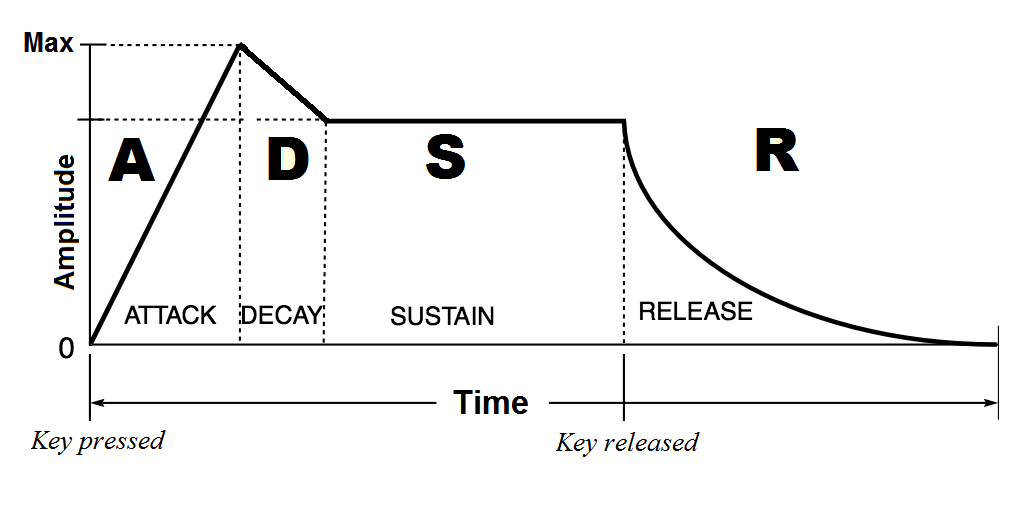
ADR – Automatic Dialog Replacement.
ADSR – Attack, Decay, Sustain, Release. These elements define the sounds (or envelope) generated by a keyboard instrument or synthesizer. See also AHDSFR.
ADT – Automatic Double Tracking or Artificial Double Tracking.
advance ball – a small, highly polished ball usually made of sapphire that rests on the uncut surface of the disc on a cutting lathe that rides ahead of the cutterhead stylus. It controls the cutting depth when creating master of a vinyl record. It must be kept extremely clean and is usually polished with a small leather cloth between cuttings. Some lathes use an electronic servomechanism to control depth instead of an advance ball.
Advanced Audio Coding (AAC) – a method of compressing and encoding digital audio developed by Bell Laboratories, Fraunhofer Institute, Dolby Labs, Sony, and Nokia. It is designed to achieve better sound quality than MP3 at similar bit rates and file sizes. AAC has been made part of the MPEG-2 and MPEG-4 specifications. There are several types (profiles) of AAC encoding used for various applications, which are usually automatically selected by the encoder based on encoding options: AAC-LC (Low Complexity) profile, which is suitable for higher compression ratios, AAC-LD (Low Delay) profile which optimizes playback speed, used for real-time applications such as telephones, and HE-AAC (High Efficiency) profile, which has enhanced features.
advanced authoring format (AAF) – a platform-independent file format developed by the Advanced Media Workflow Association (AMWA) for the transfer of digital media files between a variety of digital audio workstations and audio and video editors, used in the video post production and authoring environment. It was created to address the problem of incompatibility of multi-vendor, cross-platform digital video production formats. AAF is similar to OMF, but contains more information than the OMF, such as volume automation and track names. See also BXF, MXF, and XML.
Advanced Media Workflow Association, Inc. (AMWA) – an organization that focuses on the industry move to IP-based architectures. It was founded in 2000 as the Advanced Authoring Format (AAF) Association, Inc., but changed its name in 2007 to reflect the direction and scope of the association. To enable software-based systems to recognize and work effectively with media devices, the AMWA has developed the Networked Media Open Specifications (NMOS) that complement the work of other technology associations, such as the Audio Engineering Society, (AES), the European Broadcasting Union (EBU), the Society of Motion Picture and Television Engineers (SMPTE), and the Video Services Forum (VSF). AMWA projects strive to achieve compatibility between AAF, BXF, MXF, and XML.
Advanced Video Coding (AVC) – a video compression standard based on motion-compensation used for the recording and distribution of video content, supporting resolutions up to 4096 × 2304, including 4K UHD. Also known as H.264, MPEG-4 Part 10, or MPEG-4 AVC. See also High Efficiency Video Coding (HEVC).
Advent Corporation – a consumer electronics company founded by Henry Kloss in 1967. It manufactured loudspeakers, televisions, cassette players, and other electronic devices. In 1981, long after Kloss had left Advent, the company went into bankruptcy, and it was acquired by Jensen Electronics. In 2004, Jensen was acquired by Audiovox, which became VOXX International in 2012.
Aeolian mode – one of the seven musical modes or scales with the interval pattern of tone-semitone-tone-tone-semitone-tone-tone. This is also known as the natural minor scale.
aerial – see antenna.
aeroacoustics – the study of the generation and transmittance of sound by fluid flow or the study of aerodynamic forces interacting with surfaces.
aerophone – a classifications for musical instruments in which a vibrating mass of air produces the initial sound according to the Hornbostel-Sachs system of musical instrument classification. This classification includes woodwind, brass, and free-reed instruments, as well as instruments that fall into none of these groups. The other four classifications are idiophone, membranophone, chordophone, and electrophone.
AES – Audio Engineering Society.
AES3 – a professional audio standard for an interface developed jointly by the Audio Engineering Society (AES) and the European Broadcast Union (EBU), formerly known as AES/EBU. The standard provides the technical details for transmitting digital audio signals over a cable. There are three types of connection in common use: (a) Type I - Balanced XLR, (b) Type II - Unbalanced RCA, and (c) Type III - Optical. Type I connections use balanced, 3-conductor, 110-ohm twisted pair cables with XLR connectors, typically used in professional installations. They are considered the AES3 standard connector. Type II connections use unbalanced, 2-conductor, 75-ohm coaxial cables with RCA connectors, typically used in consumer audio installations. They are known as S/PDIF connections. Type III use fiber-optic cables, commonly known as TOSlink cables. Type III optical connections are used in both professional and consumer audio equipment. They are also known as optical S/PDIF connections. Standard IEC 60958 also covers such digital interfaces.
AES3id – a subset of the AES3 (AES/EBU) digital audio interface standard with different hardware requirements. While AES3 specifies balanced 110-ohm connections, AES3id specifies unbalanced 75-ohm connections, the same as as S/PDIF connections, except AES3id usually uses BNC connections rather than RCA connectors. Although the data format is identical for both interfaces, some bits in the data blocks have different meanings, which can make the two interfaces incompatible with some equipment.
Comparison of AES3 and S/PDIF |
|||||
| AES3 | AES3 | AES3id | S/PDIF | S/PDIF | |
|---|---|---|---|---|---|
| AES Type | Type I | Type II | Type III | ||
| Interface | Balanced | Balanced | Unbalanced | Unbalanced | |
| Connector | XLR | CAT 5 | BNC | RCA | TOSlink (F05) |
| Cable | Shielded Twisted Pair |
CAT 5 | Coax | Coax | Optical Fiber |
| Conductors | 3 | 2 | 2 | 2 | |
| Impedance (Ohms) | 110 | 110 | 75 | 75 | |
| Output Level (Vpeak-peak) | 2-7 | 2-7 | 1.0-1.2 | 0.5-0.6 | 0.5-0.6 |
| Max Current (mA) | 64 | 64 | 1.6 | 8 | 8 |
| Min Input (V) | 0.2 | 0.2 | 0.32 | 0.2 | 0.2 |
| Max Distance (m) | 100 | 400 | 1000 | 10 | 10 |
AES3-MIC – a microphone that conforms to the AES42 digital microphone interface standard.
AES10 – a standard established by the Audio Engineering Society (AES) that defines the Multichannel Audio Digital Interface (MADI). MADI can carry either 56 or 64 channels on a single coaxial or optical connection. The AES10 standard has features in common with the two-channel AES3 interface.
AES11 – a standard established by the Audio Engineering Society (AES) for the synchronization of digital audio signals. AES11 recommends using a specific form of an AES3 signal to distribute audio clocks within a facility, a connection referred to as a Digital Audio Reference Signal (DARS).
AES17 – a standard established by the Audio Engineering Society (AES) that defines a method of evaluating the dynamic range performance of A-D and D-A converters.
AES31 – a standard established by the Audio Engineering Society (AES) for the interchange of digital audio projects between different systems, especially audio editing projects between DAWs. The standard is divided into three parts. Part 1 specifies the disk format. Part 2 defines the file format. Part 3 defines a standard for edit decision lists.
AES42 – an extension of the AES3 (AES/EBU) standard to digital microphones and includes the ability to transmit and receive data along with the digital audio signals. The audio information is carried as AES3 data, while a modulated 10-volt phantom power supply conveys remote control and clocking data. This data provides the ability to remotely control parameters, such as polar pattern, low cut filter, attenuation, preamplification, mute, and polarity, as well as feedback about signal levels and the status of the mic.
AES47 –
a standard established by the AES as a standardized method for packing AES3 professional digital audio streams over Asynchronous Transfer Mode (ATM) networks.
AES51 – a standard established by AES that specifies a method of carrying Asynchronous Transfer Mode (ATM) cells over Ethernet for use with AES47 to carry AES3 digital audio transport structure. The purpose of this is to provide an open standarid, Ethernet-based approach to the networking of linear (uncompressed) digital audio with extremely high quality-of-service along with standard Internet Protocol connections.
AES59 – a specification established by AES for 25-pin D-Sub connectors used for multi-channel balanced analog connections or for multi-channel AES3 (AES/EBU) digital connections. Currently there are primarily two D-Sub wiring methods: (a) TASCAM, used by TASCAM, Avid, Universal Audio, RME, and others, and (b) Yamaha, used by Yamaha, Apogee, Mackie, Lynx, SSL, and others. Since these two are not compatible, this standard (which uses the TASCAM pin out) was created to standardize D-Sub pinouts.
AES67 – a standard established by AES for audio over IP (AoIP) and audio over ethernet (AoE) interoperability. It specifies a baseline set of protocols to enable synchronized audio connectivity between AoIP and AoE using various using various audio networking systems, such as standards for clock synchronization, quality of service, and methods to bridge between different AoIP implementations.
AES70 – a standard established by AES for Open Control Architecture (OCA), a communications protocol, originally proposed by the OCA Alliance in January 2016, to control, monitor, and manage connections of media networks (networked audio and video devices). It allows for the creation and deletion of signal paths, access control, control of processing, and firmware updates. Control can be via wired Ethernet or WiFi. OCA is an open standard that requires no licenses, fees, or memberships.
AESC – American Engineering Standards Committee. See American National Standards Institute (ANSI).
AES/EBU interface – see AES3.
AES II – refers to an AES3 Type II connector.
AES standards – standards established by the AES for use in the audio industry. Some of those standards are listed above. Others can be found on the AES Standards page of their website.
aftertouch – a MIDI message for the amount of pressure applied to a key when it is pressed down. See also keyboard expression.
AF – (1) Audio Frequencies. See audio spectrum. (2) Alternate Frequency. See Radio Data System.
A-filter – see A-weighted.
AFL – After Fade Listen.
AFNOR – Association Française de Normalisation. The French national standards organization.
A-format – the raw format produced by many commercial tetrahedron microphones that must be processed using software or hardware into a second set of signals called the B-format. See also Ambisonics.
AFM – (1) American Federation of Musicians. (2) Audio Frequency Modulation.
AFT – Anatomical Transfer Function. See head-related transfer function.
after fade listen (AFL) – a signal taken after the main channel fader on consoles and mixers. This signal point allows the operator to listen after the main fader level. Also called post fade listen, but since PFL indicates pre fade listen, AFL is used for this abbreviation. See also APL and PFL.
after processing listen (APL) – a signal used for monitoring the post-processing signal on consoles and mixers. See also AFL and PFL.
aftertouch – MIDI data sent from a keyboard when pressure is applied to a key after it has been struck and is being held down or sustained. Aftertouch can be used to control vibrato, volume, and other parameters. Also called pressure sensitivity. See also keyboard expression.
AFTRA – American Federation of Television and Radio Artists. See SAG-AFTRA.
AGAC – American Guild of Authors and Composers. AGAC is a performance rights organization that protects the rights of artists and publishers and collects and distributes royalties to its members. Much smaller than ASCAP, BMI, and SESAC, AGAC primarily represents modern classical composers.
AGC – Automatic Gain Control.
aggregator – see digital music aggregator.
AGOTTVS – Audio Guidelines for Over-the-Top Television and Video Streaming.
aharmonic – see inharmonic.
Ah – Ampere-hour.
AHD – Auditory Hemispheric Dominance.
AHDSFR – Attack, Hold, Decay, Sustain, Fade, Release. Parameters found on some advanced synthesizer envelope generators. See also ADSR.
AI – Audio Interface.
.aif – file extension for the AIFF format.
AIFF – Audio Interchange File Format. AIFF is an audio file format used by Apple for storing sound data on computers and other electronic audio devices. These files use the .aif extension and are most commonly used on Apple Macintosh computer systems. See also BWF and WAV.
AIFF-C – a compressed version of AIFF. Sometimes designated AIFFC.
AIM – Amplitude Intermodulation Distortion. A type of distortion in which one signal causes amplitude modulation of another signal.
AIMS – Alliance for IP Media Solutions.
air – the quality of having spaciousness or openess. See airy.
AIR – (1) Advanced Instrument Research. A group within Avid that develops virtual instrument plug-ins for Pro Tools . (2) Always In Record. Leaving a tape machine or DAW in the record mode at all times in order to capture everything that goes on during a session.
air gap – a security method in which one or more computers are physically isolated from unsecured networks, such as the internet or unsecured local area networks. An air gap can be either physically separated computers or computers that use dedicated cryptographic methods to prevent computers on opposite sides of the gap from communicating. Also called air wall or air gapping.
air gapping – see air gap.
air motion transducer – see air motion transformer.
air motion transformer (AMT) – a type of loudspeaker driver, invented by Dr. Oskar Heil, that operates similar to but different from a ribbon driver, consisting of a ribbon made of polyethylene, polyester, or polyimide, folded into an accordion pleat and positioned within a high-intensity magnetic field. It opens and closes in a manner similar to human vocal cords so that it “squeezes” air molecules rather than pushing them. Also called an air motion transducer.
air motion transformer tweeter – see tweeter.
airplay – (1) Broadcast time given to the playing of a song, movie, or other recording. (2) Exposure on broadcast radio.
air pressure – see atmospheric pressure.
air wall – see air gap.
airy – a descriptive term for a sound with the feeling of spaciousness or openess, a quality that allows the sound to breathe a little, usually affected by frequencies above 12 kHz. Compare with shimmer.
Akai – a consumer electronics company founded in 1929 as Akai Electric Company, Ltd. In 2000, the business, which had fallen on hard times, began to license the Akai name to rebrand electronics manufactured by other companies, and is now headquartered in Singapore. Akai Professional separated from the consumer products company in 1999 and is no longer associated with it.
Akai Professional – a company manufacturing and selling electronic instruments and recording equipment, that began business as a new division of Akai in 1984. In 1999, Akai Professional was acquired by a US company and became Akai Professional Musical Instrument Corporation, but it went bankrupted in 2005. It was acquired by Numark Industries and Alesis. In 2012, Numark, including Akai Professional, became a part of inMusic Brands.
AKG – a company founded in Vienna, Austria, in 1947 as Akustische und Kino-Gerate Gesellschaft m.b.H. (Acoustic and Cinema Equipment, LLC). Originally, it supplied audio and other equipment to the cinema industry. In 1949, it began producing headphones. It added microphones in 1953 with the introduction of the D 12, the first dynamic, cardioid-pattern microphone, and later the same year the C 12 condenser microphone. Today it is an American-owned manufacturer of consumer and professional audio products, such as microphones, headphones, and wireless microphones. The company was acquired by the American company Harman International Industries in 1994.
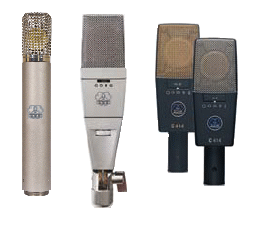
C-12 (L), Early C 414 (C),
Current C 414s (R)
AKG C 12 – a tube condenser microphone manufactured by AKG from 1953 to 1963, using the legendary CK12 microphone capsule. It featured nine polar patterns selectable remotely using an external box. The C 12 made AKG one of two dominant forces in the manufacture of commercial condenser microphones, the other being Neumann. See also Telefunken ELA M 250/251.
AKG C 12A and C 12B – an updated version of the AKG C 12 tube condenser microphone, which was released in 1962. Unlike the C 12, which was housed in a tubular body, the C 12A used a trapezoidal design similar to the familiar C 414 design. The C 12A still had nine remote-controlled polar patterns and used the same CK12 capsule, but it used a new circuit that replaced the 6072 vacuum tube with an RCA 7586 Nuvistor tube. The Nuvistor was a subminiature tube designed in 1953 to compete with the then new transistor technology. Later the C12 B was introduced, which had a slightly larger body and an added pad switch to accommodate higher SPLs. In all other respects, the A and B versions were identical.
AKG C 412 – a condenser microphone introduced by AKG in 1970. The C 412 was a successor to the C-12 and was the first FET-designed condenser microphone. It was very soon replaced in 1971 by C 414, which had only a few minor changes from the C 412.
AKG C 414 – a condenser microphone introduced by AKG in 1971. The C 414 replaced the C 412, and began the series that retained the C 414 designation, but subsequent upgrades and changes in technology have been denoted by new suffixes. By some counts, there have been more than a dozen iterations, many of which are shown in the following table:
Comparison of AKG C414 Models1 |
|||||||||
| Year |
Model Number |
Phantom Power |
Polar Patterns |
Trans- former |
Capsule |
HPF Positions9 |
Pad Positions9 |
Body Color |
Grille Color |
|---|---|---|---|---|---|---|---|---|---|
| 1970 | C412 | 12V–48V | 3 | Yes | CK12/Brass Ring | 2 | Silver | Silver | |
| 1971 | C414 Combo2 | 12V–48V | 4 | Yes | CK12/Brass Ring | 2 | 2 | Silver | Silver |
| 1976 | C414EB3 | 9V–48V | 4 | Yes | CK12/Brass Ring (Later, Nylon Ring) |
3 | 3 | Silver | Black |
| 1980 | C414EB P48 | 48V | 4 | Yes | CK12/Nylon Ring | 3 | 3 | Black | Silver |
| 1986 | C414B-ULS4 | 48V | 4 | Yes | 2072-Z-00.. | 3 | 3 | Black | Silver |
| 1989 | C414B-TL5 | 48V | 4 | No | 2072-Z-00.. | 3 | 3 | Black | Silver |
| 1993 | C414B-TLII | 48V | 4 | No | 2072-Z-00097 | 3 | 3 | Black | Gold |
| 2004 | C414B-XLII | 48V | 5 | No | 2072-Z-00227 | 4 | 4 | Black | Gold |
| 2004 | C414B-XLS | 48V | 5 | No | 2072-Z-00238 | 4 | 4 | Black | Silver |
| 2007 | C414 LTD6 | 48V | 5 | No | 2072-Z-00238 | 4 | 4 | Nickel | Silver |
| 2009 | C414XLII | 48V | 9 | No | 2072-Z-00227 | 4 | 4 | Black | Gold |
| 2009 | C414XLS | 48V | 9 | No | 2072-Z-00238 | 4 | 4 | Silver | Silver |
____________________
1This data was gathered from a number of sources, which was sometimes contraditory.
2The COMBO, which was sometimes called a “comb,” came in two versions: C414C with a DIN mount and C414E with an XLR mount. As with previous AKG models in this series, the connector was part of a custom stand mount. This design was discontinued beginning with the C414EB, which used a standard XLR connection.
3EB - Extended Bass
4ULS - Ultra Linear Series
5TL - Transformerless
6LTD - Limited Edition
7Brighter capsule. Beginning with the C414B-TLII, mics with the brighter capsules had gold grilles.
8Darker capsule. Beginning with the C414B-XLS, mics with the darker capsules had silver grilles.
9Positions count the number of selections including the none or null position. For example, a pad selector showing 0, -10 dB, and -20 dB has two selections, but three positions. There is some confusion in the literature about this.

AKG D 12 – a cardioid dynamic microphone introduced by AKG in 1953. It was the world's first dynamic cardioid microphone. Although ooriginally a vocal mic, its unique design and sound established the D 12 as the standard microphone for recording kick drums and bass instruments. The design includes a special bass chamber, a cannister below the moving-coil capsule connected to it acoustically by a small tube, which boosts the frequencies in the 60 to 120 Hz range. Introduced later, the AKG D 12E was a similar mic with a few modifications, including the addition of an XLR connection.
ALAC – Apple Lossless Audio Codec.
album – a collection of audio tracks, usually by the same artist, or a compilation of music by several artists connected by a common genre or theme. Originally, an album was a collection of 10-inch 78-rpm records bundled together into a book resembling a picture album. Later the term was applied to the 33⅔-rpm vinyl LP in which a collection of tracks were assembled on the front and back of a single disc and on occasion more than one disc. Today a compact disc usually is considered an album if it contains ten or more tracks. Fewer tracks are termed an EP, usually numbering four to six tracks.
ALC – Automatic Level Control. See automatic volume control.
ALE – Apple Lossless Encoder. See Apple Lossless Audio Codec.
Alesis – a company based in Cumberland, Rhode Island, that designs and markets electronic musical instruments, digital audio processors, audio mixers, and other professional audio and recording equipment. Founded in 1984 as Alesis Studio Electronics in Hollywood, California, it is now a part of the inMusic Brands.
Alesis MasterLink – a two-track hard-disk recorder, mixing, and mastering system. The finished recording can be saved on a CD-R in either standard CD Red Book format, or a high resolution audio format that Alesis calls CD24.
algorithm – a process or set of instructions used in calculations or operations by a computer or other digital process.
algorithmic reverb – a digital simulation of reverberation using software (algorithm). Also called digital reverberation. See also convolution reverb.
alias – (1) An alternative name for an object, such as a file, variable, or device. On Macintosh computers, an alias can be assigned for files, which allows the use of an icon for the same file in different folders. Windows provides the same functionality, but calls it a shortcut. (2) A false signal that can be created with digital audio data in a process called aliasing.
aliasing – a form of distortion that can occur during the analog-to-digital conversion of a signal. When the input signal sampled is more than one half the sampling rate, only part of the signal will be digitized resulting in a false representation of the waveform. Also called foldover distortion, because the side frequencies from one harmonic “fold over” into the sideband of another harmonic.
alignment – the adjustment of azimuth of tape heads on a tape recorder to achieve the optimum performance from the particular type of magnetic tape being used.
alignment calibration tape – see alignment tape.
alignment tape – a magnetic tape prerecorded with calibrated tones used to align the heads of a tape recorder. Sometimes called an alignment calibration tape or a test tape.
alignment tone – a signal of known frequency and level used to align tape heads and sometimes to adjust recording levels. Sometimes called a line-up tone.
alla breva – see cut time.
all' ottava alta – see ottava.
all' ottava bassa – see ottava.
all-at-once recording – recording a band or musical group all performing at the same time (usually with each on a separate track), as opposed to overdubbing. Though this term is not used as often as live recording, it should be preferred since live recording can be confused with a recording made at a live performance. See also hybrid recording.
all buttons in – see all-button mode.
all-button mode – using all four of the pushbuttons designed for selecting compression ratios on a Universal Audio 1176 compressor (previously the UREI 1176). The 1176 has buttons for selecting ratios of 4:1, 8:1, 12:1 and 20:1. An unknown British engineer tried pushing all four buttons at the same time, which significantly increased overdriven distortion. This unique sound soon became widely copied in rock music mixes. Other compressor manufacturers have attempted to imitate it. It is typically used on drums, guitar, and bass to produce a dirty sound and sometimes even on vocals. The Universal Audio 1176LN plug-in software actually includes a digital emulation of the all-button mode. Sometimes called the all buttons in, four-button mode, four-buttons in, four-button trick, or British mode.
allegretto – a musical term indicating a moderately fast tempo, slower than allegro, typically 98 to 128 bpm. See chart of tempo terms.
allegrissimo – a musical term indicating a very, very fast tempo, typically 150 to 200 bpm. See chart of tempo terms.
allegro – a musical term indicating a moderately fast, quick, and bright tempo, typically 109 to 168 bpm. See chart of tempo terms.
Allen & Heath (AH or A&H) – a company founded in 1969 and headquartered in Penryn, Cornwall, England, that manufactures audio mixers, mixing consoles, and sound management systems for industrial installations. Allen & Heath is now part of Audiotonix.
Alliance for IP Media Solutions (AIMS) – a non-profit trade association that promotes the open standards for the broadcast and media industry to move to IP-based architectures from legacy serial digital interface (SDI) systems.

alligator clip – a spring metal clip with long, serrated jaws attached to a wire or cable used for making temporary connections to batteries, speakers and other devices. It is named for its resemblance to the jaws of an alligator. Also called a crocodile clip or spring clip.
Allison effect – the destructive interference pattern that occurs when a sound source is located one-quarter wavelength away from a reflective surface. This phenomenon occurs in particular when monitors at ear level (typically about 48 in to 50 in off the floor) produce a low-frequency cancelation, due to the floor-ceiling boundary effect, in the 100 Hz - 150 Hz range resulting in a dip of 5 dB - 12 dB. Named for Roy F. Allison, an acoustic engineer with Acoustic Research (AR). See SBIR.
all' ottava alta – see ottava.
all' ottava bassa – see ottava.
allpass filter – a signal processing filter designed to change the phase relationship between various frequencies, but keep the level of all frequencies essentially equal. Sometimes spelled as the less-preferred all-pass filter. See also lowpass filter, highpass filter, bandpass filter, notch filter, and slot filter.
ALMA – American Loudspeaker Manufacturers Association.
alnico – an alloy composed of iron plus aluminum (Al), nickel (Ni), and cobalt (Co). They are ferromagnetic, have high coercivity, and are used to make permanent magnets. These were the strongest magnets available until the advent of the rare earth magnets in the 1970s.
alpha version – see beta version.
alpha ferric oxide – see ferric oxide.
Altec Lansing – a company founded in 1941 that makes loudspeakers and associated audio electronics for professional, home, automotive, and multimedia applications. Motion picture sound was developed by a group of engineers at Western Electric, who formed the All Technical Products Company, in 1936. The named was changed to Altec Services Company in 1937. Altec purchased the nearly bankrupt Lansing Manufacturing Company and formed the Altec Lansing Corporation in 1941. Originally, the company serviced movie theater sound systems, but soon began manufacturing loudspeakers. They also made studio monitors from the 1940s to the 1980s. The Altec Voice of the Theater line of loudspeakers was widely used in movie theaters, concert halls, and rock concerts from the 1960s to the 1990s. In 1958, Altec was bought by James Ling, and it was moved to Anaheim, CA. In 1974 Ling spun Altec Lansing from his company, LTV-Ling-Altec. In 1984, Gulton purchased Altec Sound Products Division out of bankruptcy from the Altec Lansing Corporation. The movie theater sound installation and repair business, Altec Service Co., was sold to J. Bruce Waddell and Robert V. Gandolfi, who changed the name to ASC Technical Services. In 1995, Telex Comunications purchased Altec Lansing's parent company, EVI Audio, Inc. In 2000, it was sold to Sparkomatic and it became Altec Lansing Technologies. In 2005, Altec Lansing Technologies was acquired by Plantronics. In 2008, the company was reorganized becoming Altec Lansing LLC. In 2009, it was acquired by Prophet Equity, and in 2012, by the Infinity Group, which specializes in acquiring and turning around struggling or bankrupt consumer brands.
alteration – see chromatic alteration.
altered chord – a chord with one or more diatonic notes raised or lowered by a semitone, a process called chromatic alteration or alteration for short.
altered tuning – see alternate tuning.
alternate picking – a guitar playing technique that continuously alternates between downward and upward picking strokes, the most common method of guitar picking. When the technique is used on a single note at a high speed, it is usually referred to as tremolo picking.
alternate tuning – a method of tuning the strings of an instrument in a different manner from standard tuning. For the guitar, standard tuning is EADGBE. One well-known alternate tuning for acoustic guitar is Celtic tuning (DADGAD, commonly called “dadgad”). Another type of alternate tunings are the dropped tunings, such as dropped D (DADGBE), where the low E string is tuned down (dropped) to D and double drop D (DADGBD) in which both E strings are dropped to D. Open tuning is another type of alternate tuning. Also called altered tuning, alternative tuning, or scordatura.
alternating bass – see fingerpicking.
alternating current (ac) – electric current that reverses direction at regularly recurring intervals of time, typically 60 Hz in the US and 50 Hz in the UK. Official abbreviation is ac, but AC is commonly used. Contrast with direct current.
alternative tuning – see alternate tuning.
alto – (1) The lowest vocal range of the adult female voice, usually a range from about G below Middle C to about F above High C (G3 to F5). (2) The musical range between soprano and tenor. (3) A singer whose voice is within this range. (4) A musical instrument that plays within this range. (5) A vocal or instrumental part written in this range. (6) Another name for the viola.
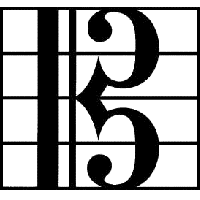
alto clef – the symbol on a music staff indicating that the third line from the bottom of a staff represents the pitch of middle C. It is one of five C clefs and is used primarily for writing music for the viola. Also called a viola clef.
AM – Amplitude Modulation.
amateur radio – the use of the radio frequency spectrum for purposes of non-commercial exchange of messages, wireless experimentation, private recreation, and emergency communications. Amateur radio operates without any direct monetary or other similar reward to differentiate it from commercial broadcasting, public safety (such as police and fire), or professional two-way radio services (such as maritime, aviation, taxis, etc.). The amateur radio service is established and regulated by the International Telecommunication Union (ITU). Amateur operators must hold an amateur radio license which is obtained by passing a government test demonstrating adequate technical radio knowledge and legal knowledge of their country's radio regulations. Also known as ham radio.
AM band – see AM radio band.
ambience – (1) The sound that comes from the surrounding environment as opposed to coming directly from the sound source. (2) The natural reverberant field of reflected sound that envelops the listener in a listening space such as an auditorium or concert hall. (3) The reverberant field of reflected sound in a listening space as captured and later reproduced using surround recording techniques. (4) Background noise. See also ambient sound. Not to be confused with ambiance, which means the atmosphere or mood of a particular environment.
ambience extraction – a method of removing out-of-phase information from a two-channel audio signal and using it to created surround channels. David Hafler developed one of the early systems of ambience extraction in the early 1960s, with a process he called Dynaquad, marketed by Hafler's company, Dynaco. A few years later, Peter Scheiber patented a similar system that competed with quadraphonic sound in the early 1970s. Dolby Laboratories cited several of Scheiber's patents when it developed the Dolby surround system. Also called pseudo-quadraphonics, Hafler hookup, and ambiophony.
ambience synthesis – a method of digitally synthesizing surround channels from in-phase information in a two-channel audio signal. Although similar in concept to ambience extraction, it uses digital technology and handles the data differently.
ambience track – the ambient sound of the sets and locations in which a scene was shot recorded by the sound editor to be used in the final mix of a motion picture or video production, used to make sure the background noise is consistent, without any unnatural changes.
ambient – (1) Pertainging to the surrounding environment. (2) A type of instrumental music designed to enhance the mood or atmosphere or induce calmness.
ambient audio – see ambient sound.
ambient field – the area away from the sound source where the reverberations are greater than at the sound source. Also called reverberant field.
ambient microphone – a microphone used for ambient miking. Sometimes called a room microphone, atmosphere microphone, or atmos mic for short.
ambient miking – placing a microphone at a distance from the sound source to capture the ambience or reverberance of the room. This sound is often mixed with a mic close to the source (called a spot microphone or accent microphone) to add presence, reverberations, or special effects or to improve tonal balance. Sometimes spelled ambient micing or ambient mic'ing. See also ambient microphone and close miking.
ambient noise – see ambient sound.
ambient sound – the background noises that are present in a scene or on location, such as wind, water, crowds, and traffic. Ambient sounds are important in video and film work because they provide audio continuity between shots, they prevent unnatural silence when there is no other sound, and they can be used to establish a mood. Also called ambient audio, ambient noise, ambience, atmosphere, atmos, background sounds, or background noise. See also location sound.
ambient sound level – the sound pressure level due to background noises at a given location, usually measured in dB relative to a reference pressure of 20 μPa (the threshold of hearing). The ambient sound level is measured with a sound level meter, frequently using A-weighting, in which case the measurements are specified in dB(A). Also called ambient noise level, background noise level, reference sound level, or room noise level.
ambiophony – see ambience extraction.
ambisonic microphone – see tetrahedral microphone.
Ambisonics – various recording and playback techniques, developed in the UK in the 1970s by the British National Research Development Corporation, that use multichannel mixing technology to create a variety of surround sound effects. The sound data can be encoded and decoded to produce a 2-dimensional (horizontal-only) or 3-dimensional (full-sphere) sound field. Unlike other surround sound formats, Ambisonics is not encoded into signals for specific speakers, but contains representations of the sound field, called the B-format, that includes source directions instead of speaker positions. This technique allows for the signal to be decoded specifically for the speaker setup at a given location or venue, allowing for a considerable amount of flexibility in the number of speakers and their position. Until recently Ambisonics has not been much of a commercial success, but with the advent of more powerful digital signal processing (as opposed to the analog circuitry used in the early years), interest in Ambisonics hs been increasing since the 1990s, especially with the advent of immersive sound. Ambisonics uses several interdependent audio tracks that can be decoded into most other end-user formats, such as stereo, 5.1 surround, 7.1 surround, immersive sound, etc. That means that only one Ambisonic recording or mix needs to be created to be used with the various formats. See also higher-order Ambisonics (HOA).
Ambisonics Channel Number (ACN) – a system for ordering the channels used in an Ambisonics format. ACN uses numerals instead of letters, with the order correspond to W X Y Z R S T U V... Unused channels are omitted.
ambiX – see higher-order Ambisonics.
AM broadcaster – a company or radio station that transmits its programming on the AM radio band.
AM broadcasting – the transmitting of radio programs using amplitude modulation.
AMEI – Association of Musical Electronics Industry.
American Association of Independent Music (A2IM) – a non-profit trade organization serving the independent music community by representing their interests in the marketplace, in the media, and in government affairs.
American Broadcasting Company (ABC) – a commercial US broadcast television network headquartered in New York City, NY, and owned by the Disney-ABC Television Group, a subsidiary of Disney Media Networks division of The Walt Disney Company. ABC originated in 1943 as a radio network when Edward J. Noble, owner of Life Savers candy and Rexall Drugs, purchased the NBC Blue Network after the FCC ordered RCA to divest its ownership. The following year, Noble acquired the rights to the name American Broadcasting Company and began using the name American Broadcasting Companies, Inc., for the parent corporation. ABC launched its television network in 1948. In the mid-1950s, ABC merged with United Paramount Theatres, a subsidiary of Paramount Pictures. ABC merged with Capital Cities Communications in 1986. In 1996, most of Capital Cities/ABC's assets were purchased by The Walt Disney Company. In 2007, it sold the radio portion of the business to Citadel Broadcasting, becoming almost exclusively a television network.
American Federation of Musicians (AFM) – a union of performing artists and musicians. AFM membership guarantees that musicians will be paid at the minimum rate established by the union (union scale). Signatory companies (those having signed an agreement with AFM) can only hire union musicians and must pay union scale.
American Graphophone Company – a company founded in 1887 and licensed by the Volta Graphophone Company to manufacture the Graphophone. The Columbia Phonograph Company was founded in 1889 to sell the products manufactured by the American Graphophone Company. In 1895, the American Graphophone Company merged with the Columbia Phonograph Company, with the former conducting research and manufacturing and the latter managing marketing, sales, and distribution. The American Graphophone Company continued the manufacturer of Columbia products until 1916, when it was reorganized as the Columbia Graphophone Manufacturing Company.
American Loudspeaker Manufacturers Association (ALMA) – an international trade organization for companies that design, manufacture, sell, and test loudspeaker components and systems.
American National Standards Institute (ANSI) – a private non-profit organization that oversees the development of voluntary standards for products, services, systems, processes, and personnel in the United States. It began as a joint effort to avoid creating conflicting standards when in 1918
six standards organizations along with the the US departments of commerce, war, and the navy established the American Engineering Standards Committee (AESC). In 1928, it became the American Standards Association (ASA). In 1966, they reorganized and became the United States of America Standards Institute (USASI). The current name was adopted in 1969.
American standard pitch notation – see scientific pitch notation.
American Telephone & Telegraph Company (AT&T) – see Bell Telephone Company.
American Wire Gauge (AWG) – a set of standards used for measuring and specifying non-ferrous wire conductor sizes (diameters), used primarily in the US and Canada. The higher the gauge number, the smaller the diameter. AWG is used only for non-ferrous wire used to conduct electricity, such as copper and aluminum. Steel wire uses a different gauge (the Washburn & Moen Gauge, which is also called the American Steel and Wire Gauge, or Steel Wire Gauge for short). AWG is also known as the Brown & Sharpe wire gauge. Household wiring typically is 12 or 14 gauge, whereas studio and audio wiring is usually in the range of 16 to 22. Some diameters for a sampling of AWG values is shown below:
| AWG. |
Diameter (in) |
Diameter (mm) |
|---|---|---|
| 2 | 0.2576 | 6.5430 |
| 4 | 0.2043 | 5.1892 |
| 6 | 0.1620 | 4.1148 |
| 8 | 0.1285 | 3.2639 |
| 10 | 0.1019 | 2.5883 |
| 12 | 0.0808 | 2.0532 |
| 14 | 0.0641 | 1.6281 |
| 16 | 0.0508 | 1.2903 |
| 18 | 0.0403 | 1.0236 |
| 20 | 0.0320 | 0.8128 |
| 22 | 0.0254 | 0.6452 |
| 24 | 0.0201 | 0.5105 |
| 26 | 0.0159 | 0.4039 |
| 28 | 0.0126 | 0.3200 |
| 20 | 0.0100 | 0.2540 |
ammeter – an instrument used to measure the electric current in a circuit, usually in amperes or milliamperes.
amp – (1) Abbreviatiosn for amplifier. (2) Abbreviation for ampere. (3) Abbreviation for amplitude.
AMP – Association of Music Producers.
AMPAS – Academy of Motion Picture Arts and Sciences.
Ampeg – a manufacturer of musical instruments, headquartered in Calabasas, CA, specializing in instrument amplifiers, especially bass amplifiers. It was founded by Everett Hull and Stanley Michaels as Michaels-Hull Electronic Labs in Newark, New Jersey, in 1946. Their first product was a pickup for upright basses, called the Amplified Peg, which was shortened to Ampeg. In 1949, the company was renamed the Ampeg Bassamp Company, which became the Ampeg Company in 1956. It was incorporated in 1959 as the Ampeg Company, Inc. In 1967, Ampeg became a subsidiary of Unimusic, Inc. In 1971, Ampeg was acquired by Magnavox. Music Technology, Inc. (MTI) acquired Ampeg in 1980. St. Louis Music (SLM) acquired the assets of Ampeg in 1986 after MTI declared bankruptcy. SLM was purchased by LOUD Technologies in 2005. In 2018, Yamaha acquired Ampeg from Loud.
amp emulator – see amplifier modeler.
amperage – the magnitude of an electrical current as expressed in amperes.
ampere – a unit for the measurement of electric current. One ampere equal to one coulomb of charges passing in one second (1 ampere = 1 coulomb/sec). Named for André-Marie Ampère. Abbreviated as A. Called amp for short.
ampere-hour (Ah) – the amount of electric charge equal to a steady current of one ampere flowing for one hour, or 3600 coulombs. The ampere-hour is used to measure the charge in electrochemical systems, such as electroplating and batteries. Also called amp-hour.
Ampex – a company founded by Alexander Matthew Poniatoff in 1944, as the Ampex Electric and Manufacturing Company. Ampex was one of the first companies to produce high-qulaity tape recorders. They also produced the first commercially successful videotape recorder, the
quadruplex.

Microphone Connector
Amphenol connector – a variety of connectors manufactured by the Amphenol Corp. One of these was a 3-pin connector used on some older model microphones, in particular the Shure 55. There was also a 9-pin Amphenol connector used to connect a Hammond organ with a Leslie speaker. See also Tuchel connector.
amp-hour – short for ampere-hour.
amp modeler – short for amplifier modeler.
amp sim – short for amplifier simulator. See amplifier modeler.
amp simulator – short for amplifier simulator. See amplifier modeler.
amplification – the process of increasing the strength or level of a signal using an amplifier.
amplification factor (mu) – the ratio of the output voltage change to the input voltage change of a vacuum tube. Also called gain or mu (μ). See also dynamic amplification factor.
amplifier – an electronic device that increases the strength or level of an audio signal passing through it. Sometimes called an electric amplifier or electronic amplifier, to distinguish it from an acoustic amplifier, which amplifies sound by non-electical means.
amplifier classes – categorization of amplifiers by their circuit configuration and methods of operation. The main operating characteristics of an ideal amplifier are linearity, signal gain, efficiency, and power output. There are always trade offs between these characteristics. The class of amplifier is important in the recording studio because the different classes add differing amounts of distortion as well as somewhat pleasing harmonics. Amplifier classes fall into two main groups. The first group contains the classic designs which include class A, class B, class AB, and class C. The second group of amplifiers are the newer “switching” amplifier classes, such as class D, class E, class F, class G, class H, and class T. These classes use digital circuits and pulse width modulation (PWM) to constantly switch the signal between “fully-on” and “fully-off” modes.
amplifier emulator – see amplifier modeler.
amplifier modeler – software or hardware that simulates the sound of a particular guitar amplifier/cabinet combination. Some modelers have the option of choosing a virtual microphone to simulate the capture of the sound. Also called amp simulator, amplifier simulator, amp sim, amplifier emulator, amp emulator, cabinet simulator, cabinet sim, cab sim, cabinet emulator, cab emulator, cabinet modeler, cab modeler, guitar amplifier modeler, guitar amp modeler, guitar amplifier emulator, guitar amp emulator, guitar amplifier simulator, guitar amp simulator, guitar amp sim, guitar amplifier modeler, guitar amp modeler, guitar cabinet simulator, guitar cab simulator, guitar cab sim, guitar cabinet emulator, guitar cab emulator, guitar cabinet modeler, guitar cab modeler, or virtual amplifier.
amplifier profile – settings used to simulate a particular guitar amplifier setup. The Kemper Profiling Amplifier (KPA), designed by Christoph Kemper, founder of Access Music Electronics, captures the sonic characteristics of an amp by playing a series of test tones through it and making a digital analysis of the result. The analysis takes a “snapshot” of a specific setup (a particular amplifier/cabinet combination with controls set in a specific way and with a particular microphone setup). The KPA allows users to create and share such profiles. Profiles are said to be extremely accurate models of the original amplifier and speaker cabinet for a given set of conditions.
amplifier sim – see amplifier modeler.
amplifier simulator – see amplifier modeler.

amplify – to increase the strength or level of an or audio signal. This process can use either an acoustic amplifier or an electronic amplifier.
amplitude – the magnitude of change in the oscillation of a wave (especially sound waves or radio waves). It is the height of the plot of a waveform as measured from an imaginary center line to the wave peak. For sound waves amplitude is a indication of loudness. See also wavelength and frequency.
amplitude distortion – see nonlinear distortion.
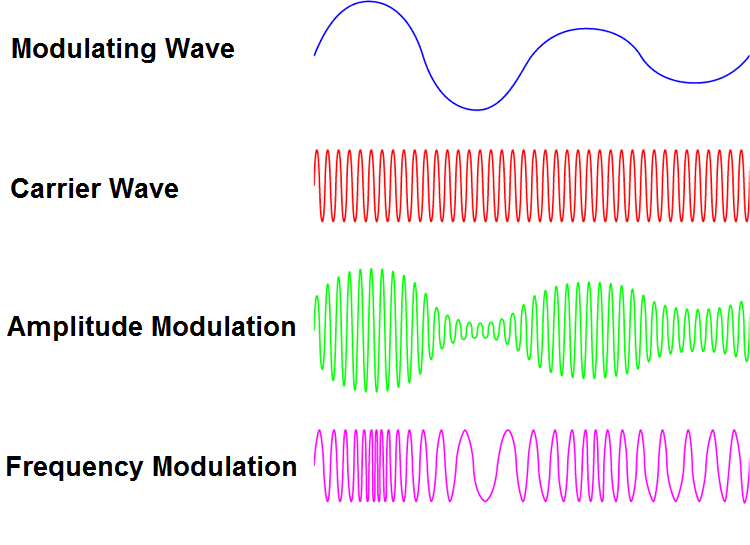
amplitude modulation (AM) – (1) A method of changing a waveform by altering (modulating) its amplitude in response to an input signal. (2) A radio broadcast method that uses amplitude modulation.
amplitude modulation synthesis (AM Synthesis or AMS) – a type of sound synthesis in which the amplitude of a signal is altered (modulated) by the amplitude of another signal. The signal that is being modulated is called the carrier, and the signal creating the modulation is called the modulator. In classical AMS, both the modulator and the carrier are oscillators. The carrier can also be other types of signals, such as an instrument or vocal signal.
amp sim – see amplifier modeler.
amp simulator – see amplifier modeler.
AM radio – the broadcasting of radio programs using amplitude modulation.
AM radio band – the portion of the radio frequency spectrum from about 550 kHz to 1600 kHz (in the US—some countries use other ranges) and using amplitude modulation.
AM receiver – (1) An electronic device (a radio receiver) that receives incoming amplitude modulated (AM) radio waves and converts them into sound or data.
AM rejection – the ability of an FM receiver to reject signals from AM transmitters and AM noise generated by electrical devices and natural sources. Also called AM suppression.
AMS – (1) Adobe Media Server (2) Audio MIDI Setup. (3) AM Synthesis.
.ams – the file extension for the Ableton Live AMS file.
AMS file – a file created in Ableton Live that allows one to save waveforms created with the Ableton synthesizer operator using amplitude modulation synthesis (AMS). It uses the .ams file extension.
AMS Neve, Ltd. – a company headquartered in Burnley, Lancashire, UK, that designs and manufactures professional audio and recording equipment. It began as Neve Electronics, which was founded in the 1960s by Rupert Neve, who designed and built mixing consoles. Rupert Neve sold the company in 1973 to the Bonochord Group and left the company in 1975. Rupert Neve went into business as ARN Consultants, which eventually became Ruper Neve Design, LLC. In 1985 Neve Electronics was acquired by the Siemens group. Siemens then acquired Advanced Music Systems (AMS) and combined it with Neve Electronics in 1992 to form AMS Neve.
AM station – a radio station that transmits its programming on the AM radio band.
AM stereo – the broadcasting of stereophonic sound audio on the AM radio band using a technique that is compatible with standard AM receivers. In 1993 the FCC designated quadrature amplitude modulation (QAM) or (C-QUAM) (similar in concept to FM stereo) as the method for AM stereo broadcasts in the US. Although initially a large number of stations implemented stereo broadcasting, that number soon began to decline due to a lack of receivers and a migration of music to the FM radio band with AM becoming primarily news, talk, and sports programming.
AM suppression – see AM rejection.
AMT – Air Motion Transformer.
AMT tweeter – see tweeter.
AMWA – see Advanced Media Workflow Association.
analog – an electronic system that uses a continuously varying signal to represent a physical variable, such as the current produced by a microphone representing sound pressure, as opposed to digital, which uses a stream of binary digits to represent such a variable. The British spelling is analogue.
analog computer – a type of computer that uses models to solve problems by representing the data as a continuously variable physical phenomenon, such as electricl voltage or current, mechanical rotation of gears, or fluid flow. In contrast, digital computers solve problems using numerical values. British spelling analogue computer.
analog chorus – see chorus.
analog delay – a processor that runs incoming audio through analog circuits that delay the signal that is then played back after a specified time period. It may add additional effects such as regeneration and feedback to create the sounds of an echo. See also digital delay. British spelling analogue delay.
analog domain – the processing of images, sounds, video, and other data in their original analog format, as opposed to the digital domain.
analog filter – an electronic circuit that reduces certain frequencies of an analog signal leaving the rest, as opposed to an digital filter, which is an algorithm that performs a similar operation on a digital signal. British spelling analogue filter. See also filter.
analog opto-isolator – see resistive opto-isolator.
analog recording – the process of recording analog audio for later playback as a continuous wave in or on an analog medium, such as grooves on a phonograph record or magnetic fluctuations on a magnetic tape, as opposed to digital recording, in which such information is stored as data. British spelling analogue recording.
analog signal – a continuous signal in which a variable varies with time and is analogous to some other time-varying variable. For example, an analog audio signal is a voltage signal that represents the varying pressure of sound waves. It differs from a digital signal in that the quantity is represented by binary digits and can have only one of a finite number of values. British spelling analogue signal.
analog synthesis – a method to create and manipulate sound using electronic oscillators, filters, and envelopes. This technique was used on older analog synthesizers and keyboards. British spelling analogue synthesis.
analog summing – see summing.
analog synthesizer – see synthesizer.
analog television – the system in which television signals were broadcast, received, and displayed using analog technology. The interlaced video portion of the signal was transmitted using AM, while the audio was transmitted using FM. In the US analog television broadcasting ended on June 12, 2009, except for a few educational or low-powered transmitters, and was replaced by digital television (DTV). See also NTSC and ATSC.
analog-to-digital conversion – the process of changing an analog signal into a digital signal that contains essentially the same information, using an analog-to-digital converter. Abbreviated as AD conversion, A-D conversion, A/D conversion, and A-to-D conversion. British spelling analogue-to-digital conversion.
analog-to-digital converter – an electronic device or circuitry that converts an analog signal into a digital datasteam. Audio quality depends very greatly on the accuracy of the analog-to-digital converter and the digital-to-analog converter. Abbreviated as AD converter, A-D converter, A/D converter, A-to-D converter, and ADC. British spelling analogue-to-digital converter.
analyzer – see audio analyzer or spectrum analyzer.
anamorphic format – a system in which an image is recorded in a narrower aspect ratio to be subsequently displayed or projected in its original aspect ratio. For example, a widescreen picture can be shot on standard 35-mm film in a non-widescreen aspect ratio and then stretched back to the original widescreen aspect ratio when projected.
anatomical transfer function (ATF) – see head-related transfer function.
ANC – Active Noise Control. See noise cancellation.
andante – a musical term indicating a moderate tempo, at a walking pace, typically 72 to 108 bpm. See chart of tempo terms.
andantino – a musical term indicating a moderate tempo, slightly faster than andante, typically 77 to 106 bpm. See chart of tempo terms.

andante moderato – a musical term indicating a slow tempo, slower than andante, typically 69 to 78 bpm. See chart of tempo terms.
anechoic – free from echoes and reverberations. Literally, non-echoing.
anechoic chamber – a room in which the reflection of sound waves are minimized and which is isolated from external sources of sound. An acoustically dead space. Also called an anechoic room. Sometimes called an acoustic anechoic chamber to distingish it from rooms used for waves other than sound, such as electromagnetic waves.
anechoic room – see anechoic chamber.
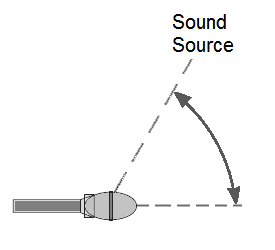
angle of incidence – the angle between a sound source and the axis of a microphone. Also called sound incidence angle.
angle of maximum rejection – the angle at which a directional microphone picks up the least amount of sound. This angle is important because it aids in positioning a microphone to minimize feedback from monitors and to minimize bleed from nearby instruments. For a microphone with a cardioid pattern, the highest rejection is 180° (directly behind the mic). For a supercardioid pattern, the most effective rejection is about 125° from the front of the mic. A hypercardioid pattern has the most effective rejection at about 110° from the front of the mic. A figure-eight pattern has the most rejection on the the sides (90°). Also called null angle and rejection node. Also see chart of Comparison of Microphone Polar Patterns.
angular acceleration – the rate of increase or decrease in angular velocity. It is usually represented by the Greek letter alpha (α).
angular frequency (ω) – the measure of rotation rate, and can refer to circular rotation, oscillations of a wave, or the rate of change of a sine function, usually in units of radians per second. It is essentially the same as angular velocity without the directional component. It refers to the angular displacement per unit time (e.g., in rotation) or the rate of change of the phase of a sinusoidal waveform (e.g., in oscillations and waves), or as the rate of change of the argument of the sine function. Also called angular speed, radial frequency, circular frequency, orbital frequency, or radian frequency.
angular speed – see angular frequency.
angular velocity (ω) – a vector quantity that specifies the rotational speed (angular speed) of an object and the direction of rotation, usually in units of radians per second. Other units are sometimes used, such as degrees per second or radians per hour. A vector specifies both speed and direction. The direction is perpendicular to the plane of the rotation. Compare with angular frequency, which is not a vector quantity. See also constant angular velocity.
anisotropy – the condition of having properties that are directionally dependent. It is the opposite of isotropy. Of particular concern with recording tape formulations is the anisotropy of magnetic particles, which can have preferred directions of magnetization. The anisotropy of these particles depend upon their shape, their crystalline structure, or the stress within them.
anode – (1) A positively charged electrode. (2) In a vacuum tube, the anode is the plate that produces the output signal.
ANR – Active Noise Reduction. See noise cancellation.
ANSI – American National Standards Institute.
answer print – the first corrected print of a film production, made from the A and B rolls, including the soundtrack. It is sometimes called a married print because it is the first time that picture and sound appear together on the same piece of print stock. If the print does not include the soundtrack, it is called a black-track print. The answer print is also designated as the first answer print, since after further timing corrections the next print is called the second answer print, followed by a third answer print, and so on.
Antares Audio Technologies – a company located in Scotts Valley, CA, that develops and markets audio software and equipment. It was founded in 1990 as Jupiter Systems by Dr. Harold (Andy) Hildebrand. Antares is probably best known as the developer of Auto-Tune®.
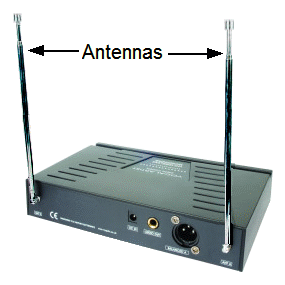
antenna – an element in an electric circuit, usually consisting of a wire or rod, used to transmit or receive radio signals, sometimes extending up or protruding from a transmitter or receiver. Also called an aerial.
antenna directivity – the measure of the directional characteristics of an antenna. The directional pattern depends on the antenna design, its size, the environment, and a variety of other factors. The pattern should be used to ensure that the signal is aimed in the desired direction. See also directional antenna.
antenna diversity – a system used with wireless microphones to improve reception and minimize signal dropouts by automatically switching between two antennas based on which is receiving the strongest signal. See also diversity and true diversity.
antenna efficiency – the amount of power radiated by an antenna compared to the power delivered to the antenna or the amount of power delivered by an antenna compared to the power received by the antenna. Compare with antenna gain.
antenna gain – the ratio of the power produced by an antenna as compared to the power produced by a hypothetical lossless isotropic antenna, usually expressed in decibels-isotropic (dBi). Compare with antenna efficiency.
antenna splitter – a device that electrically matches one antenna to multiple receivers.
anti-aliasing filter (AAF) – a lowpass filter used before a analog-to-digital converter to attenuate frequencies above the Nyquist frequency to prevent aliasing. Compare with anti-imaging filter.
anticipation – a technique of melodic or rhythmic alteration in which a note is played slightly before the beat causing syncopation. When the anticipation occurs in the melody, it is called a melodic anticipation. An anticipation that occurs one-half beat early is called an eighth note anticipation. One that is a quarter of a beat early is a sixteenth note anticipation, while one-third of a beat early is a triplet anticipation. Also known as pushed notes, pushed beats, or simply pushes.
anti-imaging filter – a lowpass filter used at the output of a digital-to-analog converter that removes the high frequency signals created by the sampling process above the Nyquist frequency in order to produce a smooth waveform approaching that of the original sampled signal. Also called a reconstruction filter or smoothing filter. Compare with anti-aliasing filter
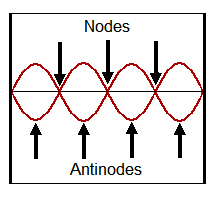
antinode – a point of maximum sound pressure level in a standing wave, as opposed to a node, which is point of a minimum sound pressure.
antinoise – see noise cancellation.
antiphase – the state in which the phase of two waves are 180 degrees apart and, therefore, in phase cancellation.
antiphonal – music played or sung interactively by two different groups of performers, often singing alternate musical phrases.
antiphony – a call and response style of singing.
antiquing – the process of making modern audio files sound as if they were old recordings or used older recording technology. The opposite of restoring old recordings.
anti-skating – a mechanism used on phonographs and turntables that compensates for the tendency of a tonearm to slide (skate) toward the center of the platter, thereby keeping the stylus in the groove. Also spelled antiskating.
AoE – Audio over Ethernet.
AoIP – Audio over IP.
APC – Association of Professional Composers. See British Academy of Songwriters, Composers, and Authors.
APD – Auto Power Down.
.ape – file extension for the Monkey's Audio format.
aperiodic – (1) Occurring at irregular intervals. (2) A waveform that it not repetitive and, therefore, has no pitch. Opposite of periodic.
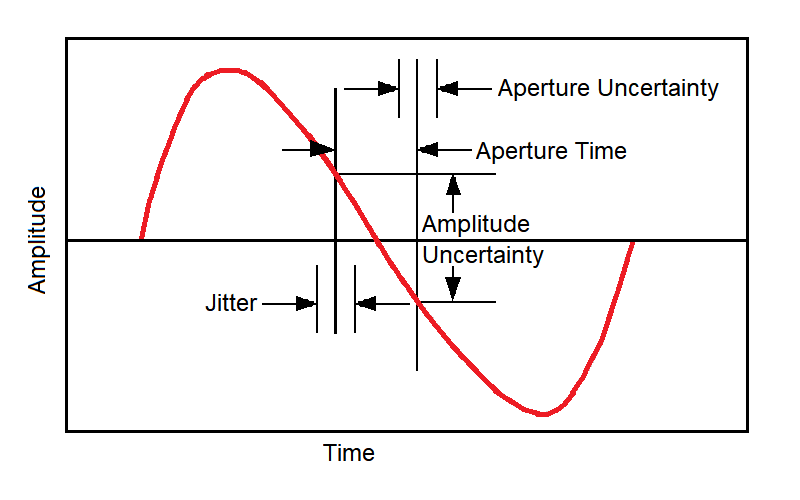
aperture time – the time it takes for the sample-and-hold (S/H) circuit in an A/D converter to determine the level of the signal waveform and to hold this value until the next sample. Because the time required to determine the next level depends on the amount of change in the signal, the aperture time will vary with the rate of signal level change, which increases for higher-frequency signals.
aperture time errors – errors due to the lack of precision in the aperture time in the sample-and-hold (S/H) circuit in an A/D converter, which can cause amplitude errors in rapidly changing signals. These errors result is distortion of the sampled signal, which rises with increasing frequency.
API – (1) Application Programming Interface. (2) Automated Processes, Inc.
API 312 – a modular preamp designed and built by API for their API 500 series. It uses 2520 op amps and is based on the preamps used in the classic API consoles of the 1970s. With its extremely flat frequency response, it delivers a very pristine sound and is considered to be an extremely versatile preamp that some have called “legendary.”

API 1604 – a 16-channel console introduced in the 1970s by Automated Processes, Inc. Although originally intended for broadcast radio stations, it soon found its way into many recording studios.
API 500 series® – see 500 series.
API 550 – an equalizer designed by Saul Walker and introduced in 1968 by Automated Processes, Inc. It was first used in API custom-designed console and had a unique sound due to the custom-designed op amps and its proportional-Q circuitry, which automatically adjusted the bandwidth based on the amount of equalization applied, eliminating the need for a bandwidth adjustment and minimizing phase shift. It is a 500 series module. It was later replaced by the 550A and then the 550b.
API Lunchbox® – see 500 series.
APL – After Processing Listen.
apodize – to change the shape of a mathematical function, an audio signal, or an optical signal to remove or smooth out a discontinuity at the edges. Literally apodize means “to remove the foot.”
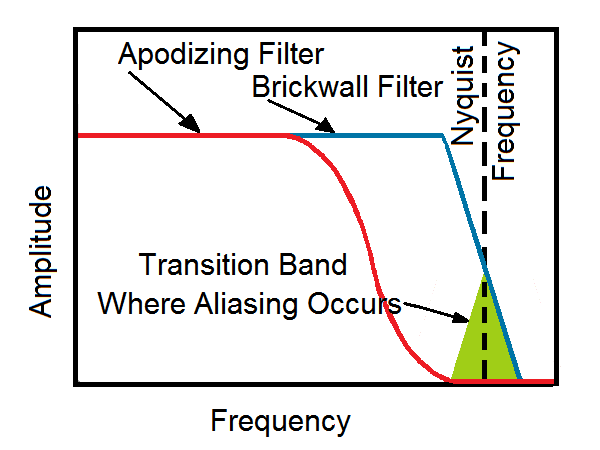
apodizing filter – a type of filter that can be used in in digital audio processing instead of the more common brickwall filter, which can introduce ringing and aliasing. See apodize.
Apogee Electronics – a company based in Santa Monica, CA that makes audio interfaces, audio software, analog-to-digital converters, and digital-to-analog converters.
app – short for application.
apparent power – a measure of power in an alternating current (ac) circuit that is calculated by multiplying the root-mean-square (rms) current by the root-mean-square voltage. In a direct current (dc) circuit, or in an ac circuit where the impedance is pure resistance, the voltage and current are in phase, and power is calculated by multiplying the rms voltage in volts by the rms current in amperes and is expressed in watts. However, in an ac circuit whose impedance consists of reactance as well as resistance, the voltage and current are not in phase, and the product of the rms voltage and the rms current is called apparent power, and is expressed in volt-amperes. When the impedance is a pure resistance, the apparent power is the same as the true power, but when there is reactance, the apparent power is greater than the true power. The vector difference between the apparent and true power is called reactive power.
Apple Corps, Ltd – a multimedia company founded in London in 1968 by the Beatles. It replaced their former company, Beatles, Ltd. Its name (pronounced “apple core”) is a pun. Its main divisions are Apple Records (also launched in 1968), Apple Electronics, Apple Films, Apple Publishing, and Apple Retail.
Apple Digitial Masters – songs that have been mastered by a certified mastering engineer following certain guidelines and best practices. Among other things, Apple specifies they must have a 24 bit depth, they can have sample rate between 44.1k and 96k, but must not be upsampled, and they must not clip when converted to AAC. They must be submitted to a
Apple, Inc. – a multinational corporation headquartered in Cupertino, California, that designs, develops, and sells computers, consumer electronics, and computer software.
Apple Logic – see Logic Pro.
Apple Logic Pro – see Logic Pro.
Apple Lossless – see Apple Lossless Audio Codec.
Apple Lossless Audio Codec (ALAC) – an audio codec developed by Apple, Inc., for lossless data compression of digital music. Although originally proprietary, it is now a free, open source format. It uses the .m4a file extension. Also called Apple Lossless and Apple Lossless Encoder (ALE).
Apple Lossless Encoder (ALE) – see Apple Lossless Audio Codec.
Apple Music – a pay-for-services music and video streaming service created by Apple Inc. in 2015. Similar to Pandora and Spotify, users can select music to stream to their device on-demand, or they can listen to existing, curated playlists.
Apple Spatial Audio – an immersive audio technology developed by Apple Inc. that is compatible with Apple products. It provides an immersive soundscape which includes using dynamic head tracking for a “theatre-like” experience. Apple says that with Spatial Audio sounds can be placed “virtually anywhere” in the 360°hemisphere.
application – a computer program, or group of programs, that is designed to to perform functions, tasks, or activities. Applications include such things as word processors, database programs, and spreadsheets. In the recording studio, they include digital audio workstations and plug-ins. Also called application software, computer programs, or app for short.
Application Programming Interface (API) – a set of subroutine definitions, protocols, and tools for building computer applications. APIs are used to provide clearly defined methods of communication between various software components, making it easier to develop a computer application by providing all the needed building blocks. An API may be used for an internet-based system, operating system, database system, or computer hardware. See also web audio API.
application software – see application.
APPV – Audio Post Production for Video.
APRS – Association of Professional Recording Services. A British organization of recording, mastering, and replication studios who establish standards of service for these facilities.
APRS tape-labeling system – a standard method of color coding recording tape as established by the APRS.
| Color | Label | Description |
|---|---|---|
| Blue | Session Tape | The original recordings—the working tape onto which material is recorded and overdubbed and may contain out-takes. An album project may be made up of several session tapes. |
| Red | Original Master | The first generation two-track (stereo) tape, but one that is not necessarily suitable for production. |
| Green | Production Master | All EQ and effects have been added for the specific format (vinyl, cassette, CD, etc.) and the tracks should be in final order with fade outs when used. |
| Orange | Production Master Copy/Clone | A copy is an analog copy and will undergo some degeneration, while a clone is a digital copy and will be identical to the original. This is the version submitted for manufacturing so that the original may to be retained. |
| Grey | PQ-Encoded Master Tape | A U-Matic tape with PQ encoding for glass mastering for producing CDs. |
| Pink | Safety Copy/Clone | A backup copy or clone strictly for safety. |
| Yellow | Not for Production | Any tape that is not intended to be used as a source for manufacturing. |
| Yellow | Media Version | A copy or clone made for radio broadcast, video or film soundtrack, or similar purposes. Details should be included on the label. The label should have check boxes for radio, TV, film, or video. |
APWPT – Association of Professional Wireless Technology.
AR – (1) Audio Restoration. (2) Acoustic Research. (3) Augmented Reality.
A&R – Artists and Repertoire. The department or individual at a record label that manages the talent (Artists) and the music they write or perform (Repertoire). It is the job of the A&R person to scout, select, and sign performers to the label, as well as act as the liaison between the artist and label. Although specific duties vary by label, A&R people may also decide what songs to record, select musicians to work with the artist, and help with arranging and performing the music.
archival stability – the ability of a storage medium for audio, video, or film to retain its data in a readable form over time. Archival stability is determined by past performance and testing that simulates long-term storage conditions. Magnetic tape has a relatively low stability, while optical media is considered to have a very long stability. However, how long is anybody's guess.
archive – (1) To save records or documents for an extended period of time, either for historical preservation or for long-term safekeeping. (2) To store audio files on a hard drive or other media when a recording session is completed. (3) See disable.
architectural acoustics – (1) The science of controlling the noise within a building space. (2) The qualities of a building and its materials that determine the sound properties within it.
archtop guitar – see top, defintion #2.
arithmetic mean – an average that equals the sum of several number or values divided by the number of numbers or values. Sometimes called simply mean or average. See also geometric mean, harmonic mean, and median.
A-roll – see B-roll.
ARG – Acoustic Rhythm Guitar.
arm – see wiper or record enable.
ARM – Associated Radio Manufacturers. See Electronic Industries Alliance.
armed – see record enable.
ARN Consultants – see Rupert Neve Designs.
arp clock – short for arpeggio clock.
arpeggiate – to play the notes of a chord one after another rather than simultaneously, either descending or ascending.
arpeggiator – a device that electronically creates and plays an arpeggio. Many synthesizers have this capability built in.
arpeggio – (1) The notes of a chord played in succession rather than simultaneously, either descending or ascending. (2) A chord played or sung in such a manner.
arpeggio clock – a device in a DAW, MIDI device, or synthesizers that controls the timing of notes played by an arpeggiator, based on the timeline. Called arp clock for short.
arrange – to adapt a written piece of music for a particular style of performance by voices or instruments. Arranging involves adding different compositional techniques, such as reharmonization, modulation, changing intros or endings, and alternate transitions.
arranger – the person who arranges a written piece of music.
array – see line array
arrival time – see interaural time difference.
ARSC – Association for Recorded Sound Collectors.
articulate – see detailed.
artifact – see audio artifact
artificial double tracking – see automatic double tracking.
artificial head technique – see sphere microphone technique.
artificial reverb – reverberation that is created in a space built for that purpose (echo chamber) or using electromechanical devices (plate or spring reverb), hardware effects processors, or software algorithms (digital reverb), as opposed to natural reverb.
artificial stereo – see simulated stereo.
ASA – (1) Acoustical Society of America. (2) American Standards Association. See American National Standards Institute (ANSI).
ASCAP – The American Society of Composer, Authors, and Publishers. ASCAP is one of three performance rights organizations in the US that protects the rights of artists and publishers and collects and distributes royalties to its members. The other two PROs are BMI and SESAC. See also Global Music Rights.
ASCII – American Standard Code for Information Interchange. A standard code for representing computer keyboard characters as binary data, in which alphabetic, numeric, or special characters are represented by 7-bit binary numbers.
ASF – Advanced Systems Format. A proprietary digital audio/digital video container format from Microsoft, intended for streaming media. Formerly known as Advanced Streaming Format and Active Streaming Format.
A side – Back when singles were released on 45-rpm vinyl records (and 78-rpm singles before that), record labels would designate an A side and a B side, with the A side intended to be played on the radio and hopefully become a hit. Occasionally, a radio disc jockey would flip a record over and play the B side, which sometimes resulted in a B-sided hit. Fairly infrequently, both sides of single would become a hit, a so-called two-sided hit. The media would sometimes write this as “Title A” b/w “Title B,” where b/w meant “backed with”. The B side was sometimes called the flip side, but has come into common usage equivalent to the phrase “on the other hand.” Interestingly, records were originally issued with grooves cut in only one side, until the 1910s when someone realized you could produce a two-sided disc for about the same cost a single-sided disc.
ASIO – Audio Stream Input/Output. A standard for audio drivers that provides high performance and low latency on PC-based computers. Apple's Mac computers use Core Audio
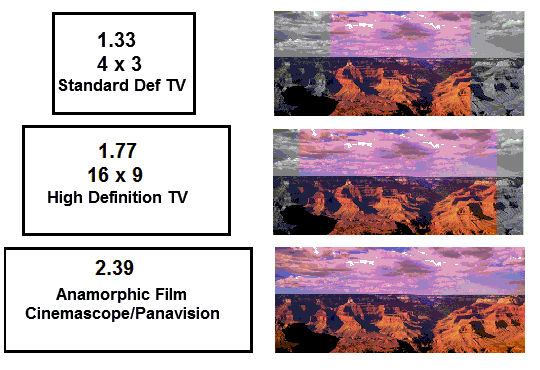
aspect ratio – the width-to-height ratio of an image, especially as applied to film and video. The most common aspect ratios used for movies are 1.85:1 and 2.39:1. The aspect ratio of standard definition television (PAL and NTSC) was 4:3 (1.33:1). For high definition television, it is 16:9 (1.77:1).
asperity – a minute imperfection or irregularity in the magnetic coating of recording tape, which can cause variations in head-to-tape contact, asperity noise, and increased friction. Also called surface asperity.
asperity noise – noise manifested as a low-frequency rumble caused by asperities, minute imperfections in the oxide coating of a recording tape.
aspiration – the expulsion of breath while speaking or singing, such as the “H” sound in the word how or the “P” sound in the word pie. Compare with plosive.
assemble editing – editing of an audio or video recording by piecing together (assembling) various takes from a master tape, rather than physically splicing pieces of tape together. Most digital editing is done in this manner. The opposite of insert editing.
assign – to route or send an audio signal to one or more channels or buses.
assignment – the bus or buses designated to send and/or return an audio signal to or from a device.
assistant engineer – see assistant recording engineer.
assistant recording engineer – someone who helps the recording engineer, with duties that vary by studio, such as placing microphones, setting up and breaking down equipment, and maintaining session logs. Also called assistant engineer, second recording engineer, second engineer, and second.
Associated Radio Manufacturers (ARM) – see Electronic Industries Alliance.
Association for Recorded Sound Collectors, Inc. (ARSC) – an organization of record collectors, librarian, curators, and researchers, established in 1966 in Silver Spring, Maryland. The purpose of the group is to enhance communications among sound archivists and to encourage research.
Association of Musical Electronics Industry (AMEI) – an organization founded in 1996 and headquartered in Tokyo, Japan, to create standards to assure compatibility among electronic musical instruments, especially those using MIDI.
Association of Music Producers (AMP) – a US organization founded in 1997 for the purpose of educating its members, and the production, advertising, and media industries, on all facets of music production, from creation to final use. It is concerned with business matters, such as production guidelines, composer royalties, music rights agreements, and educational seminars. It also presents the annual AMP Awards.
Association of Professional Wireless Technology (APWPT) – an independent association, working for the benefit of professionals who use the radio-frequency spectrum. It promotes on an international level the efficient and demand-driven provision and use of production frequencies for professional event productions as well as safeguarding such production frequencies for the users on the long run.
Astatic Corporation – a manufacturer of audio products for recording and live performance, as well as commercial and personal audio, located in Solon, Ohio. The Astatic Microphone Laboratory, Inc. was founded in Youngstown, Ohio in 1933, by Creed M. Chorpening, F.H. Woodworth, and, Charles Semple to develop and manufacture crystal microphones for ham radio operators. They later added crystal phonograph cartidges and recording heads. Astatic moved its operations to Conneaut, Ohio, in early 1944, and began supplying products to the military during World War II. After the war, Astatic Microphone Laboratory became the Astatic Corporation. In 1988, the commercial audio product division of Astatic became CAD (Conneaut Audio Devices) Professional Microphones. Astatic merged with Omnitronics, LLC in 2000, and CAD, Astatic, and Omnitronics began operation under the CAD Audio brand. The Citizens Band (CB) division of Astatic was acquired from Omnitronics by Barjan, LLC in 2006, and then sold to DAS Companies in 20212.
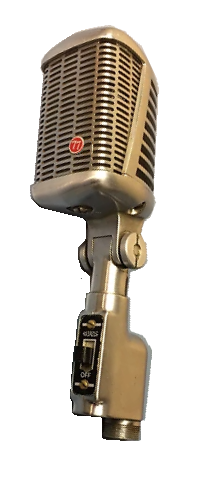
Astatic A77 – a cardioid, large diaphragm, side-address dynamic vocal microphone introduced by Astatic in 1959. It had a stylish appearance, and a wide dynamic range (for that time) of 30 - 15,000 Hz.
asterisk array – an arrangement of several different microphones around a single point so they can be tested by a vocalist or musician. This term was coined by Bruce Kaphan.
ASTM International – an international standards organization that develops and publishes voluntary technical standards for a variety of materials, products, systems, and services. Headquartered in West Conshohocken, PA, it has offices in Canada, Mexico, Belgium, China, and Washington, D.C. It is the oldest of the standards organization having been founded in 1898 as the American Section of the International Association for Testing Materials (IATM). In 1902, it was renamed the American Society for Testing Materials. In 1961, it became the American Society for Testing and Materials. Then in 2001, it changed its name to ASTM International.
Astra Digital Radio (ADR) – a now obsolete digital satellite radio service introduced in Europe in 1995 that used the audio subcarrier frequencies of analog television stations. It was succeeded by DVB-S, with which it was incompatible.
ASX – Advanced Stream Redirector. A special type of file which works in conjunction with Windows Media ASF files. The ASF file is the actual media file, containing audio, video, and other media. The ASX file is a metafile (a file which contains data about another file) and is a simple text file containing a reference to an ASF file. ASX files provide Windows Media Player with information about how to present particular media items of the playlist and to start the ASF file streaming.
asymmetrical clipping – the opposite of symmetrical clipping.
asynchronous – a method of digital transmission in which there is no fixed timing. See synchronous.
A-T – Audio-Technica.
ATC – Absolute Time Code.
AT&T – American Telephone & Telegraph Company. See Bell Telephone Company.
A-taper – see taper.
A-time – see absolute time.
ATIP – Absolute Time In Pregroove.
atm – abbreviation for atmosphere, when referring to the unit of pressure.
atmos – short for atmosphere, when referring to ambient sound.
atmos mic – short for atmosphere microphone. See ambient microphone.
atmosphere – (1) The collection of gases surrounding the earth. (2) The air or climate in a specific place. (3) The pervading tone or mood of a place. (4) The background noises that are present in a scene or on location, such as wind, water, crowds, and traffic. Also called ambient sound. (5) A unit of pressure defined as 101,325 pascals (Pa), 1,013.25 millibars, 760 torr, 29.92 in Hg, or 14.696 psi. Its symbol is atm. Sometimes called a standard atmosphere. See also atmospheric pressure.
atmosphere microphone – see ambient microphone.
atmospheric pressure – is the force per unit area (pressure) exerted by the weight of air in the atmosphere above it. As elevation increases, there is less overlying atmospheric mass, so atmospheric pressure decreases with increasing elevation. A standard atmosphere is equal to 1 atmosphere (atm), 101,325 pascals (Pa), 101.325 kilopascals, 1,013.25 millibars, 760 torr, 29.92 in Hg, or 14.696 psi. Also called barometric pressure.
A to D converter – see Analog-to-Digital converter.
atonal – music not written in any key or mode. The opposite of tonal.
ATR – Audio Tape Recorder, as opposed to a video tape recorder (VTR). (2) Analog Tape Recorder, as opposed to a digital tape recorder (DTR).
ATRAC – Adaptive TRansform Acoustic Coding. A family of proprietary audio file formats developed by Sony. Originally developed as a lossy format for use with the MiniDisc, it has had several improvements over the years, such as ATRAC3, ATRAC3plus, and ATRAC Advanced Lossless. ATRAC files usually have an .aa3 or .oma file extension.
ATSC – (1) Advanced Television Systems Committee. The agency that developed the standards for digital television transmission in the US and several other countries. (2) The standards for digital television transmission developed by the committee. ATSC replaced the analog NTSC television system in the US on June 12, 2009. With the adoption of ATSC 3.0, the original ATSC standard is now referred to a ATSC 1.0.
ATSC 1.0 – see ATSC, definition #2.
ATSC 3.0 – the latest standard currently being formulated by the ATSC for digital television. The orginal standard, previously referred to simply as ATSC is now being referred to a ATSC 1.0. (See ATSC, definition #2.) The new standard offers support for newer technologies for over-the-air televison, cable television, satellite television, and internet television. It includes many new improvements for improved television viewing, including HEVC, resolutions of up to 2160p (4K resolution), frame rates of 120 fps, wide color gamut, Dolby AC-4, MPEG-H 3D Audio, and the capabilty for datacasting. In the US, the FCC approved regulations in November 2017 allowing broadcast stations to voluntarily offer ATSC 3.0 services, but they must be offered along with a standard ATSC digital signal. Unlike the transition from analog NTSC to digital ATSC, this transition will not be mandatory.
ATSC A/85 – the standard recommended by the ATSC for implementing audio loudness control for digital television under the ITU BS.1770 standard. This standard differs only slightly (primarily the target loudness level) from the European version under EBU R128.
attack – (1) The beginning of a note as it rises from near silence to its maximum level. Drums have a fast attack, while bowed strings have a slow attack. (2) The first of the four segments of an ADSR envelope. (3) Short for attack time.
attack time – the time it takes for a device or circuit to react to an input. Attack time is a parameter used to set compressors, limiters, compressors, synthesizers, and other devices. Called attack for short.
attenuate – to reduce the level of an electrical, acoustic, or audio signal.
attenuation – the reduction in level of an electrical, acoustic, or audio signal.
attenuation distortion – see frequency distortion.
attenuator – a device that reduces the level of a signal.
attenuator pad – one of several circuit designs used to reduce the level of a signal. See L-pad, T-pad, and H-pad.
AU – (1) An audio file format originally introduced by Sun Microsystems and commonly used in Unix and Java systems, as well as on early web pages. It uses a simple 8-bit μ-law algorithm to encode data at a sample rate of 8000 Hz, although other sample rates are sometimes used. Although originally headerless, newer files have a header consisting of six 32-bit words and an optional information section. These files use the extension .au or .snd. Also known as the SPARC (Scalable Processor Architecture) format or μ-law format. (2) Abbreviation for Audio Units.
.au – file extension for AU format.
Audacity – a free open-source digital audio workstation available for Windows, Mac OS X, Linux, and other operating systems, developed by Dominic Mazzoni and Roger Dannenberg at Carnegie Mellon University.
audible – able to be detected or heard by the human ear. See also threshold of hearing and audio spectrum.
audible frequencies – see audio spectrum.
Audinate Pty Ltd. – a company founded in 2006 and headquartered in Ultimo (Sydney), Australia, that develops and markets Dante, a system for transmitting digital audio over (AoE). After Motorola closed its Australian research facility in 2003, a team of researchers took their research to the National Information and Communication Technology Australia (NICTA) in Sydney, Australia, where with the help of government funding, they began to develop Dante. In 2006, Audinate was founded to bring Dante to the market.
audio – (1) Vibrations (sound waves) that are detectable by the human ear as sound. From the Latin audio, meaning “I hear.” See also audio spectrum. (2) Sound that is transmitted, recorded, reproduced, or broadcast, whether acoustically, electrically, or digitally. (3) Pertaining to audible sound. (4) The sound portion of a movie or television broadcast. (5) A sound signal.
audio analyzer – an instrument used to test and measure audio performance of electronic and electro-acoustical devices, using a variety of parameters, such as level, gain, noise, distortion, frequency response, and crosstalk. See also spectrum analyzer.
audio analysis – the process of testing and measuring audio performance of electronic and electro-acoustical devices, using a variety of parameters, such as level, gain, noise, distortion, frequency response, and crosstalk. See also spectrum analysis.
audio artifact – any unwanted distortion that was not in the original audio signal usually caused by a limitation or malfunction in the audio hardware or software.
audio bandwidth – see audio spectrum.
audiobook – the recording of the reading of a book, typically a novel, but non-fiction and technical books are also available. Originally these were sold on cassette, but later became available on CD. Sometimes called a talking book or book on tape.
audio bus – see bus.
Audiobus (AB) – a standalone iOS application and a developer API developed by Audiobus Pty. Ltd. It provides for the realtime routing of audio from one iOS app to another. For example, if two iOS apps support Audiobus, you can set the output of the first app to Audiobus, and then select Audiobus as the audio input in the second app, the audio from the first app will be available in the second app for additional processing or recording. Audiobus has been approved by Apple, and it is supported by many instruments, effects, and iOS DAWs, such as Apple's GarageBand. See also Inter App Audio (IAA).
audio capture – see capture.
audio cassette – see cassette.
audio chain – the series of audio equipment used to obtain a recording or to amplify a live performance, such as microphone, preamp, amplifier, and speaker. Also called a program chain.
audio channel – see channel.
audio clip – see clip, definition #3.
audio coding – another term for data compression of audio files.
audio coding format – a method for storing or transmitting digital audio files, such as MP3, AAC, Vorbis, and FLAC. The method by which audio is compressed and decompressed is the codec. For example, LAME is the most common codec for encoding MP3 files, but there are a number of others that can be used. Audio encoded in a particular audio coding format is normally encapsulated within a container format known as an audio file format, which usually contains the encoded audio and metadata that provides such information as to the codec, bit rates, and other information needed to decompress the data, as well as title, artist, and other information. The main exception is the MP3 file, which does not use a container file. The method of adding metadata such as ID3 tags is a work around that takes advantage of the fact that MP3 players ignore such data. An audio coding specification is a document that details the technical details of the coding format. If the document has been written and approved by a standards organization, it is usually called an audio coding standard. Audio coding format is sometimes called audio compression format.
audio compression – see compression. Note: Audio compression is often used to refer to both dynamic range compression and data compression, which can lead to some confusion.
audio compression format – see audio coding format.
audio compression manager (ACM) – a mostly obsolete Microsoft program for managing audio codecs on Windows platforms. Files encoded with this process use the extension .acm, and are usually stored in a wrapper such as WAV or AVI.
audio coding specification – see audio coding format.
audio coding standard – see audio coding format.
audio data reduction – data compression of an audio file.
audio definition model (ADM) – metadata that can be included in BWF wave fileswwwwwww that is used to describe object-based audio, scene-based audio, and channel-based audio, as specified in ITU-R BS.2076.
audio editor – see sound editor, definition #2.
audio engineer – see sound engineer.
Audio Engineering Society (AES) – a professional organization established in 1948 for engineers, scientists, other individuals with an interest or involvement in audio technology and the professional audio industry.
audio expansion – see expansion.
audio feedback – see feedback.
audio file – a digital audio recording that can be stored in a computer or other digital medium such as a hard disk. Also called a sound file, soundfile, sound bite, or digital music file.
audio file format – a method for storing digital audio data as a file on a computer system, which can be either compressed or uncompressed. The method by which audio is compressed and decompressed is the codec and is separate from the file format. The method in which a codec is presented is called an audio coding format. The audio file format is a container format, which usually contains the encoded audio and metadata that provides such information as the codec, bit rate, sampling rate, and other information needed to decompress the data, as well as title, artist, and other information. Audio file formats are usually indicated by their extension. Some formats can use more than one codec. For example, a WAV file can be encoded using PCM, MPEG3, and several other codecs. Uncompressed formats include WAV (.wav), AIFF (.aif), BWF (.bwf), and AU (.au), as well as a raw format, which has the PCM-coded data, but no header or metadata. There are several formats with with lossless compression, such as FLAC (.flac), Monkey's Audio (.ape), WavPack (.wv), True Audio, (.tta), ATRAC Advanced Lossless (.aa3), Apple Lossless (.m4a), MPEG-4 ALS, MPEG-4 SLS, MPEG-4 DST, Windows Media Audio Lossless (.wma), and Shorten (.shn). Formats with lossy compression include MP3 (.mp3), Ogg Vorbis (.ogg), Musepack (.mpc), Advanced Audio Coding (.mp4), ATRAC (.aa3), RealAudio (.ra), and Windows Media Audio Lossy (.wma).
audio filter – see filter.
audio format – see audio file format.
audio frequencies – see audio spectrum.
audio frequency modulation (AFM) – a method of recording high quality analog audio used on VHS Hi-Fi and Hi 8 video systems.
audio glitch – see glitch.
audio grain – a small (25 ms to 100 ms) overlapping snippet of sound that can be manipulated in various ways, such as for time expansion/compression. See also granular synthesis and granulation.
Audio Guidelines for Over-the-Top Television and Video Streaming (AGOTTVS) – guidelines established by an AES technical group formed in early 2016 for managing the loudness of soundtracks of television and video content for consurmers via over-the-top (OTT) and online video distribuotrs (OVD).
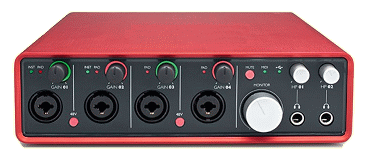
audio interface (AI) – a device that connects between an audio source or sources and a computer and converts the audio into a digital signal that can be used by the computer. It can be as simple as a connector with analog-to-digital conversion or as complex as a control surface with mutliple audio inputs, preamps, faders for level control, level indicators, panpots, and other controls plus A/D conversion. Sometimes called a digital audio interface or simply interface.
audio loop – see loop.
audio mastering – see mastering.
Audio MIDI setup (AMS) – a utility program that comes with the Mac OS X operating system to set up the audio input/output (IO) configurations of the computer and to manage MIDI devices.
audio mixer – see mixer.
Audion – a vacuum tube used to amplify weak electric signals invented by Lee De Forest in 1906. The Audion was the first triode and consisted of a partially evacuated glass tube with three electrodes: a heated filament, a grid, and a plate. It was the first widely used tube used for amplification. De Forest thought that a small amount of gas should be present in the glass tube, unlike later vacuum tubes. However, this was not the case as it caused erratic performance. Within a few years, the Audion was superseded by improved versions with higher vacuums, and eventually by the developement of the transistor.
audio network – see audio over Ethernet or audio over IP.
audio oscillator – a device that produces a signal with a wide range of frequencies and with a variety of waveforms. See also signal generator.
audio over Ethernet (AoE) – a method of transmitting real-time high-quality, low-latency, multichannel digital audio over an Ethernet network. AoE uses standard networking cabling in place of snake cables or audio-specific low-voltage wiring. AoE can be used in a variety applications such as large-scale sound reinforcement and multiple studios or stages. There are several competing, but mostly incompatible, systems available, both open and proprietary. This include Dante, CobraNet, EtherSound, AVB, and MADI. Also called an audio network.
audio over IP (AoIP) – a method for streaming audio over great distances using an IP network. IP stands for Internet Protocol, a set of communication protocols used on the internet and similar computer networks. AoIP is used by broadcasters and others to provide high-quality audio feeds using the Internet. It is also known as audio contribution over IP (ACIP), referring to contributions made by field reporters and remote events. For transmitting audio locally, such as within a music venue or within a building, audio over Ethernet (AoE) is the more likely choice to avoid the problems associated with AoIP. Also called an audio network.
audiophile – a person who is enthusiastic about high quality sound reproduction.
audio player – see media player.
audio plug-in – see plug-in.
audio port – see port.
audio post production – see audio post production for video.
audio post production for video (APPV) – any audio work done after completing the shooting of a film or video, such as replacing dialog, adding sound effects, and adding music. Post production is the process of preparing the final mix of the soundtrack that will be synchronized with the video, which includes television, movies, and commercials. The typical order for this operantions is: (a) dialog editing, (b) automatic dialog replacement, (c) sound design, (d) Foley, (e) music composition and editing, and (f) mixing. Also called audio post production, post production, or post for short.
audio processing – see signal processing.
audio processor – see signal processor.
audio rack – see equipment rack.
audio receiver – see AV receiver.
audio recorder – see recorder.
audio recording – see recording.
audio recording programs – see audio recording software.
audio recording software – computer programs used with various pieces of hardware to record, playback, mix, edit, and store digital audio files. The combination of the software and hardware is called a digital audio workstation (DAW). A list of such programs can be found at the digital audio workstation entry.
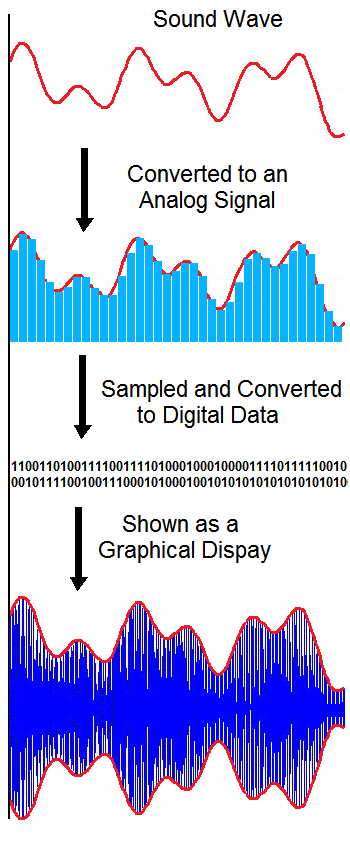
in Various Forms
audio restoration (AR) – the process of removing pops, clicks, hum, hiss, and other noises from an audio file. Although it was originally developed to clean up vintage recordings, it is often applied to current audio files. See also denoiser.
audio signal – an analog representation of sound, usually as an electrical voltage, or a digital representation, that can be stored in an audio file format. Audio signals are usually produced by a transducer, such as a microphone, instrument pickup, phonograph cartridge, or tape head or they may be synthesized. Audio signals are converted back into sound using loudspeakers or headphones. Also called a sound signal.
audio signal processing – see signal processing.
audio signal processor – see signal processor.
audio silence – a diagnostic recording made with the tape machine in record mode, but with all faders down, providing a means to measure the noise floor and/or bias noise.
audio snake – see snake.
audio source – (1) The origin of an audio signal, such as the output from a microphone, instrument, or other device, that is the input to a track on a mixer, console, recorder, or DAW. See also sound source. (2) A switch on some tape machines that selects between between monitoring the signal from the tape and the signal originating at the input (the source).
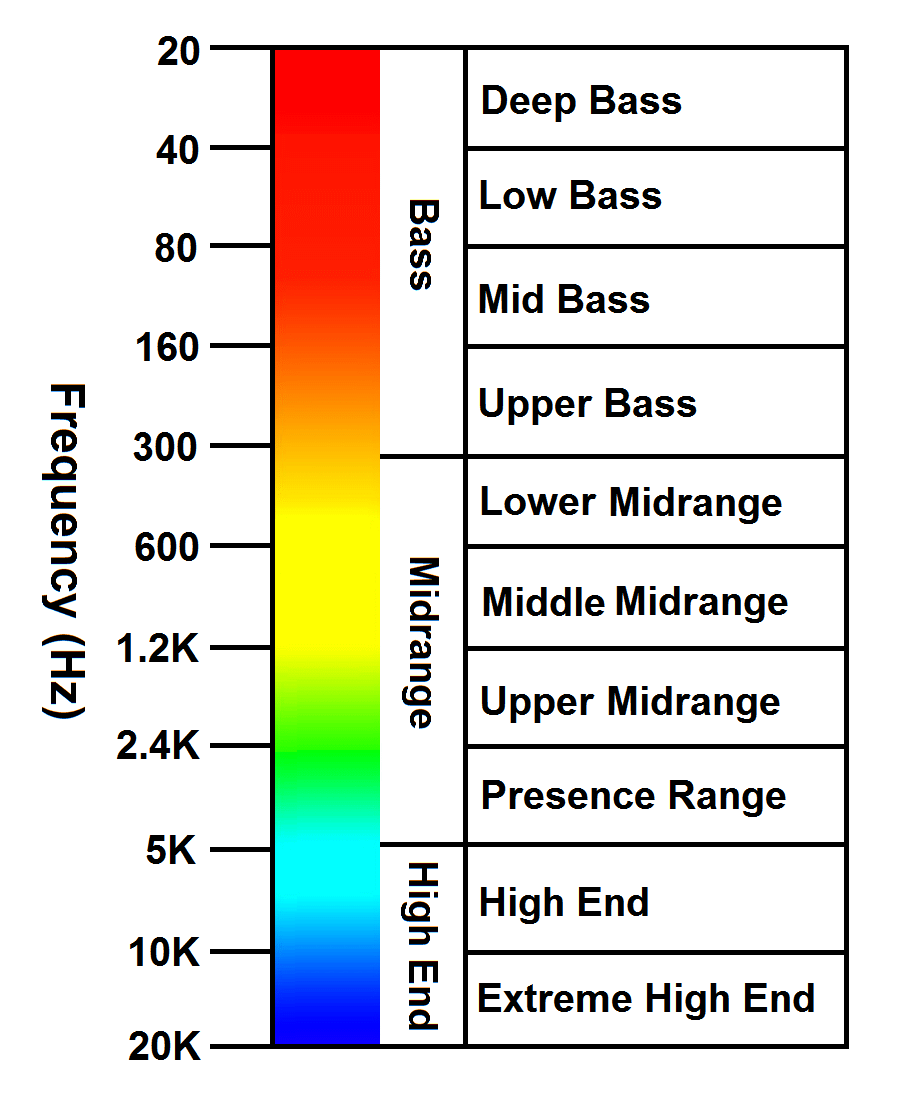
audio spectrum – the audible frequencies of human hearing, which generally is considered to be between 20 Hz and 20,000 Hz (20 kHz), which is about 10 octaves. There is considerable variation in this range among individuals, especially for the higher frequencies, and there is usually a gradual decline in the ability to hear higher frequencies with age. Also called the audio bandwidth, aural bandwith, audio frequencies, or hearing range. The audio spectrum is sometimes broken down into three main ranges: bass (20 Hz to 350 Hz), midrange (350 Hz to 5 kHz), and high end (5 kHz to 20 kHZ). These ranges are sometimes further devided into deep bass (20 Hz to 40 Hz), low bass (40 Hz to 80 Hz), mid bass (80 Hz to 160 Hz), upper bass (160 to 350 Hz), lower midrange (350 Hz to 600 Hz), middle midrange (600 to 1200 Hz), upper midrange (1.2 kHz to 2.4 kHz), presence range (sometimes called the middle highs)(2.4 kHz to 5 kHz), high end (5 kHz to 10 kHz), and extreme high end (10 kHz to 20 kHz). The exact nomenclature and frequencies differ with various sources, but are generally in the ranges specified. Also called audible frequencies or audio frequencies.
audio stream – see media stream.
AudioSuite™ – a proprietary plug-in format developed by Avid for Pro Tools. AudioSuite plug-ins can process and modify audio files offline and can be configured to either create an entirely new audio file or to alter the original audio file. See also RTAS.
audio synthesis – see sound synthesis.
audio system – a collection of components or electronic equipment used for producing amplified sound, whether in a home, car, live performance, or a public address system. See also stereo.
audio tape – (1) Magnetic recording tape used to record only audio. (2) A recording made on such a tape.
audio taper – see taper.
Audio-Technica Corporation – Kabushiki-gaisha Odio Tekunika. A company founded in 1962 in Tokyo, Japan, that designs and manufactures professional microphones, wireless microphones, headphones, magnetic phonographic cartridges, and other audio equipment. Audio-Technica introduced its first microphones in 1978 and its first wireless microphones in 1986. Sometime abbreviated as A-T.
audio technician – see audio engineer.
audio technologist – see audio engineer.
audio-to-MIDI – software or hardware that analyzes the pitches, amplitude, and timbre of an instrumental or vocal audio signal and converts it into MIDI notes and commands.
Audiotonix – an audio equipment company formed in 2014 with the merger of DiGiCo, Allen & Heath, and Calrec. In 2017, Auditonix was sold to a private equity firm in Europe. Later in 2017, Audiotonix acquired Solid State Logic (SSL).
audio track – (1) An audio channel. (2) The finished mixed down stereo or mono recording or track. An album usually contains 10 to 14 tracks, sometimes called cuts.
audio units (AU) – a plug-in format developed by Apple for Core Audio in Mac OS and iOS. It is similar to other plug-in formats such as Steinbergs VST and Pro Tools AAX. Audio units provide low latency and full two-way communication between the digital audio workstation (DAW) and the plug-ins. Apple Logic uses only AU format plug-ins, but some other DAWs, such as Ableton Live, can also use this format. The format was updated to Audio Units v2 (AU v2), with the latest version being Audio Units v3 (AU v3).
audio/video – see audiovisual.
Audio Video Bridging (AVB) – a set of technical standards developed by the IEEE Time-Sensitive Networking Task Group (formerly the Audio Video Bridging Task Group) of the IEEE 802.1 standards committee, that provides specifications to allow time-synchronized low-latency audio and video streaming services through IEEE 802 networks. See also Time-Sensitive Networking.
audiovisual (AV or A/V) – (1) Works that have both a sound and a visual component. (2) The production or use of works that have both a sound and a visual component. (3) The equipment used to create and present works with both a sound and a visual component, such as film, television, and slide-tape presentations. Sometimes called audio/video.
Audiovox – see VOXX International.
audio wave – see soundwave.
audition – (1) A test performance by a performer or musician to demonstrate suitability for a specific role, a position in a band or group, a recording contract, or other performance-related situations. (2) To monitor or to listen to a track or an audio file to assess its quality and other characteristics. (3) To listen to audio equipment to make a purchase decision.
Audition – see Adobe Audition.
auditory hemispheric dominance (AHD) – having a dominant ear in hearing. Just as most people are right-handed, most people have a dominant right ear. Although this is perfectly normal, recording engineers need to be aware of potential issues: (1) a tendency when mixing to favor panning to one particular side, (2) image localization may be more difficult for some people with a dominant left ear due to a small amount of latency in that ear.
auditory masking – see frequency masking.
Audix Microphones – a designer and manufacturer of microphones founded in 1984 and headquartered in Wilsonville Oregon. Audix makes a full line of professional microphones, but they may be best known for their microphones designed for use with drums.
au file – see au.
augment – to raise by one semitone.
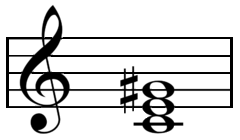
(Caug or C+)
augmented chord – a chord with two stacked major third intervals, which is equivalent to a major triad with a sharped fifth. In other words, the top note is raised by half a step. A major triad, such as C-E-G, contains a major third (C-E) and a minor third (E-G), with C-G being the interval of a fifth. The augmented triad sharpens the fifth (becoming an augmented fifth), resulting in C-E-G♯. An augmented fourth is a tritone. Augmented chords are represented by adding either “aug” or “+” such as Caug or C+. Also called a augmented triad.
augmented fifth – an interval of eight semitones. It is a semitone higher than a perfect fifth and is enharmonically the same as a minor sixth. Examples are the interval from C♭ to G or from C to G♯.
augmented fourth – an interval of six semitones. It is a semitone higher than a perfect fourth and is a tritone. An example is the interval from C to G♭.
augmented prime – see augmented unison.
augmented reality (AR) – the live view on a screen or other display of a physical, real-world environment enhanced by overlaying computer-generated images, sounds, graphics, GPS information, or other data. By contrast, virtual reality (VR) replaces the real world with a totally artificial environment.
augmented second – an interval of three semitones. It is a semitone higher than a major second, and is enharmonically the same as a minor third. An example is the interval from C to E♭.
augmented seventh – an interval of twelve semitones. It is a semitone higher than a major seventh, and is enharmonically the same as an perfect octave. Examples are the interval from C3♭ to B4 or from C3 to B4♯.
augmented sixth – an interval of ten semitones. It is a semitone higher than a major sixth, and is enharmonically the same as a minor seventh. Examples are the interval from from A♯ to F or from A to F♭. It is considered a dissonant interval.
augmented third – an interval of five semitones. It is a semitone higher than a major third, and is enharmonically the same as a perfect fourth. Examples are the interval from C♭ to E or from C to E♯. It is considered a dissonant interval.
augmented triad – see augmented chord.
augmented unison – the interval produced by raising a unison by one semitone. In other words, it is the interval between notes occupying the same position on the musical staff or notes having the same letter where one note has been raised by a semitone, such as B♭ and B or C and C♯. It is the enharmonic equivalent of a semitone or minor second. Also called augmented prime.
aural – pertaining to the ear or the sense of hearing.
aural bandwidth – see audio spectrum.
Auralex Acoustics – a company founded in 1977 and headquartered in Indianapolis, Indiana, that designs and manufactures acoustic treatments.
aural exciter – see exciter.
aural skills – see ear training.
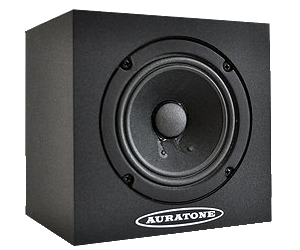
Auratone 5C Sound Cube – a speaker manufactured by Auratone, a company established in 1958 by Jack Wilson, who actively marketed them until he passed in 2005. His grandson Alex Jacobsen took over the business and updated the speakers. Recording engineers began using Auratones as secondary speaker to check translation.
Auro-3D® – an immersive audio format developed in 2005 by Auro Technologies and Barco. It is an expansion of the 5.1 surround sound format and adds overhead ceiling spekers (sometimes called the “Voice of God”), which creates a spatial sound field by adding a height layer around the audience. The height layer presents both localized sounds and height reflections that complement the existing sounds in the lower surround layer.
Auro Technologies – a company founded in 2010 in Mol, Belgium, by Wilfried and Guy Van Baelen and Alfred Schefenacker to promote and advance the Auro-3D immersive audio format. The Van Baelens also own the Galaxy recording studio.
Australian Broadcasting Corporation (ABC) – the state-owned national public broadcasting network in Australia, offering educational and cultural programming through television, radio, online, and mobile services throughout Australia, and in other countries through the Australia Network and Radio Australia. It was founded in 1929 as the Australian Broadcasting Company. In 1932, it became the Australian Broadcasting Commission. Upon passage of the Australian Broadcasting Corporation Act 1983, it took its current name.
authoring – the process of assembling source material, such as audio, video, and other data, into the proper format so that it can be recorded (burned) onto an optical disc, such as a compact disc (CD), DVD, or Bluray disc (BD). Authoring is typically done using various software applications on computers with optical disc recorders, but is sometimes done using dedicated, stand-alone devices.
autolocate – a function that sends a tape or disc to a pre-programmed position upon the press of a button.
automate – to setup and use automation to control parameters in a DAW, plug-in, or other device.
automated mixing – see automation.
Automated Processes, Inc. (API) – a company located in Jessup, MD, that manufactures high-end equipment for recording studios, such as preamplifiers, equalizers, and mixing consoles. They manufacture and own the trademark for the API Lunchbox®, a line of 500 series modules. The company was founded in 1968 by Saul Walker and Lou Lindauer. In 1973 API introduced the first computerized mixing console featuring an automation system for fader level control. One year later this system was expanded to include automation with recall of equalization, sends, pans, and faders. In 1985, API was purchased by Paul Wolff, who owned the company until 1999, when the assets of the company were sold to ATI (Audio Toys, Inc.), who manufactures sound reinforcement equipment including the Paragon mixing console.
automatic delay compensation (ADC) – a feature of most DAWs that provides computerized delay compensation that automatically corrects for timing delays caused by signal processors, plug-ins, hardware, or other processes that contributes to latency.
automatic dialog replacement (ADR) – the process of adding dialog in sync with the movie soundtrack in a sound studio after the movie has been completed. Also called post synchronization (primarily in UK and Europe) or informally dubbing. See also dub.
automatic double tracking (ADT) – a special effect that simulates double-tracking, two voices or instruments playing together, created by combining a signal with a duplicate signal that is slightly detuned and/or delayed by 15 to 35 milliseconds. ADT is similar to chorusing, but with a shorter delay. Sometimes called artificial double tracking.
automatic gain control (AGC) – a circuit that adjusts the incoming signal of an audio device to maintain a constant level in the output signal. Also called automatic volume control (AVC).
automatic microphone mixer – see automatic mixer.
automatic mixer – a special type of mixer that automatically turns microphone channels on and off as needed without user intervention. An automatic mixer is controlled by a gain-sharing algorithm, which controls the level of each individual microphone, produces a mix with a constant gain from all mics, maintains a constant acoustic gain equal to the needed acoustic gain (NAG), and optimizes the feedback stability margin (FSM). Also called an automatic microphone mixer, automatic mic mixer, microphone automixer, or automixer.
automatic power down – see auto power down.
automatic shut down – see auto power down.
automatic stop – a device on a tape machine that causes the tape transport to stop when it encounters a strip of leader tape, used for cueing the machine between segments separated by the leader tape.
automatic volume control (AVC) – see automatic gain control (AGC).
automation – a feature that allows a recording engineer to program various parameters (such as fader position, levels, or panning) to occur automatically in a console, mixer, or digital audio workstation (DAW) during mixing or playback. This process is accomplished by creating an automation curve or automation line(sometimes called an automation envelope). Sometimes called console automation, mixer automation, DAW automation, automated mixing, or automix.
automation curve – the graphical representation of the changes in automation data for a given audio or MIDI track. The curve consists of lines connected by a series of dots at each point where the parameter changes. These dots are called break point, edit points, or anchors. In some DAWs an automation curve is called an automation envelope or automation line.
automation envelope – the name used in some DAWs for the graphical representation of the changes in automation data for a given audio or MIDI track. An automation envelope may be superimposed on top of the audio or MIDI track or it may be displayed in a separate lane below the track, called an automation lane. See also clip envelope.
automation lane – a separate lane displayed below an audio track in a DAW that shows automation data. The data is shown graphically as a line usually connected by dots (automation curve).
automation line – see automation curve.
automix – see automation.
auto power down (APD) – a feature of some equipment that automatically reduces the power drain after a prescribed amount of time. Also called automatic power down, automatic shut down, or auto shut down.
auto punch – the process that allows a recording engineer to automatically overdub a specific section of a digital recording, either by highlighting that section or by entering precise start and stop information. See also punch.
autoranging – the automatic switching of the ranges on a device so that the lowest range not exceeding full-scale is used or displayed. Autoranging is sometimes used on multirange meters and input gain controls.
auto-reovery – see auto-release.
auto-release – a control found on some compressors that dynamically adjusts the release time. Auto-release provides for a fast release on louder transients and a slower release on quieter signals. This procedure helps to maintain perceived loudness, without causing pumping that sometimes occurs with a fixed release time. Also called dual-stage or auto-recovery.
auto save – a feature of some DAWs and other software that automatically saves the open files at specified intervals. Sometimes spelled autosave.
auto shut down – see auto power down.
autotune – to correct an out-of-tune vocal or instrumental performance. See also Auto-Tune.
Auto-Tune® – a pitch correction processor developed by Antares Audio Technologies that measures the pitch of a vocal or instrumental audio signal and adjusts the pitch to the nearest semitone. Auto-Tune is available as a plug-in for us professional recording studios as well as a stand-alone unit for processing live performances. Although it was originally created to correct off-key notes, it has also come into use as an effect to distort the human voice when pitch corrections are made extremely fast, which has become known as the “Cher effect” or the “T-Pain effect.”
AU v2 – Audio Units v2. An update of the Apple Audio Units format.
AU v3 – Audio Units v3. The latest veresion of the Apple Audio Units format.
aux – short for auxiliary.
aux bus – see auxiliary bus.
aux equipment – see outboard equipment.
aux fader – see auxiliary fader.
aux input – see auxiliary input.
aux loop – see effects loop.
aux master – see auxiliary master.
aux return – see return.
aux send – see send.
aux send bus – see auxiliary bus.
aux track – see auxiliary track.
auxiliary – extra or additional. Often used to describe extra inputs or extra sends, such as auxiliary inputs or auxiliary bus. Oten abbreviated as aux.
auxiliary bus – the channel (signal path) on a mixer, console, or DAW used to send and return signals to and from monitor mixes, signal processors, outboard devices, plug-ins, or other line-level inputs.. Also called effects bus, send bus, auxiliary send bus, aux bus, or aux send bus.
auxiliary equipment – see outboard equipment.
auxiliary fader – a fader used to control the signal level of an auxilliary bus in a mixer, console, or DAW. Called an aux fader for short.
auxiliary input – an extra jack for inputting miscellaneous signals from a variety of sources. Also called aux input.
auxiliary loop – see effects loop.
auxiliary master – a control on the auxiliary bus used to adjust the overall level being sent to that bus. Also called aux master.
auxiliary return – see return.
auxiliary send – see send.
auxiliary send bus – see auxiliary bus.
auxiliary track – a track in a DAW that contains no audio, but is used for processing an audio signal from other tracks. Called an aux track for short.
AV – AudioVisual. Also written as A/V.
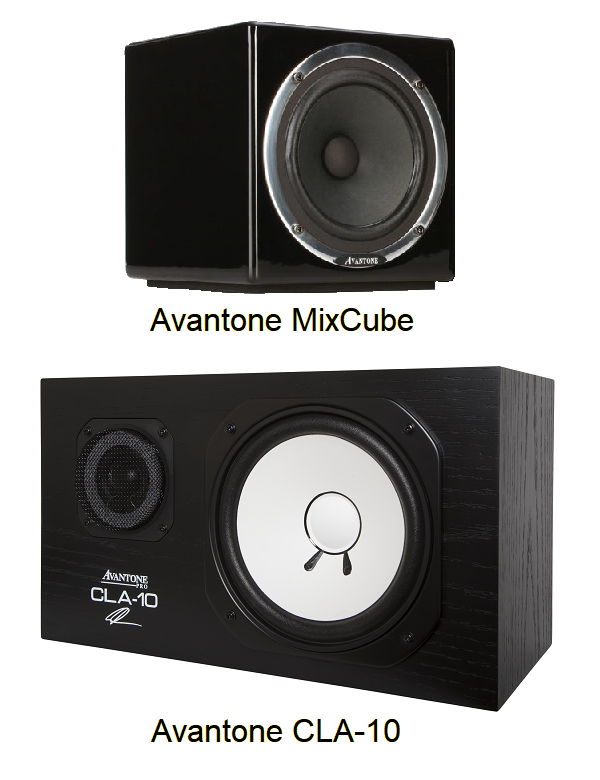
Avantone Electronics – a company established in 2003 by Ken and Sue Avant, that designs and manufactures speakers. When the Yamaha NS-10 was discontinued in 2001, Avantone designed and created the Avantone CLA-10 as a substitute. Likewise, when Auratone speakers were discontinued in 2005, Avantone designed and created the MixCubes as a substitute. Although they are designed as emulations, they are constructed differently and do not sound exactly the same. However, because the originals are no longer available, recording engineers use them as mix check speakers to check translation.
AVAA – Active Velocity Acoustic Absorber. An active bass trap designed and marketed by PSI Audio that absorbs room modes between 15 and 150 Hz. It uses a microphone to measure acoustic pressure and then drives an transducer membrane to create acoustic resistance to oppose the pressure. The company claims that this design is more efficient than passive absorbers.
AVB – Audio Video Bridging.
AVC – (1) Automatic Volume Control. See automatic gain control (AGC). (2) Advanced Video Coding.
A/V drive – Audio/Video drive. A hard disk drive specifically designed for audio and video work that allows thermal recalibration only when the disk is inactive to minimize data errors.
AVE – Avid Video Engine. The underlying code used by Avid for HD video recording, playback, and editing within Pro Tools. The Avid Video Engine provides the means of moving video data in, out, and through the system.
average – a number that expresses the central or typical value in a set of data. There are several types of averages: (a) arithmetic mean, (b) geometric mean, (c) harmonic mean, and (d) median. These various terms are frequently used in expressing audio quantities.
average bitrate (ABR) – (1) The average amount of data (typically digital audio or video) transferred per second. (2) A type of variable bitrate (VBR) encoding in which the encoder targets on an average bitrate or file size while the bitrate varies above or below that rate depending on the complexity at any given part of the audio or video. The bitrate of ABR encoding does not vary as much as that of regular VBR encoding, and usually does not produce as high of quality for a given bitrate. VBR usually produces higher quality than ABR, which produces higher quality than CBR (constant bitrate). ABR encoding provides the general benefits of VBR encoding (optimized bitrate from frame to frame) with a relatively predictable file size.
average meter – see RMS meter.
AVI – Audio Video Interleave. A video file format developed by Microsoft that combines the audio and video components together in one file. It uses the .avi extension.
Avid Technology, Inc. – a company founded in 1987 by Bill Warner and headquartered in Burlington, Massachusetts, that specializes in digital audio and video editing, management, and distribution services. In 1995, Avid merged with Digidesign, the developer of Pro Tools. However, it continued to use the Digidesign name until 2010.
Avid Customers Association (ACA) – an association run by and for Avid customer to provide a greater level of communication and engagement between Avid and its customers, partners, and users than they otherwise have as part of the general Avid Customer Community. Membership requires an annual membership fee, but those who choose not to pay remain members of the Avid Community.
AVIXA™ – AudioVisual and Integrated eXperience Association. The international trade association representing the audiovisual industry that produces InfoComm trade shows around the world, and establishes AV standards, certification, training, market intelligence, and leadership. It was founded in 1939, as InfoCom International®. Members include manufacturers, systems integrators, dealers, distributors, consultants, programmers, live events companies, technology managers, content producers, and multimedia professionals from more than 80 countries. It became AVIXA in 2017.
AVnu Alliance – a consortium of professional, automotive, and consumer electronics companies working together to establish and certify the interoperability of open Audio Video Bridging (AVB) and Time Sensitive Networking (TSN) standards. The Alliance has a program to certify AVB and TSN products that meet their criteria. The AVnu logo may be used by manufacturers on products that are certified.
AVR – AV Receiver.
AVRCP – Audio/Video Remote Control Profile. See Bluetooth profile.
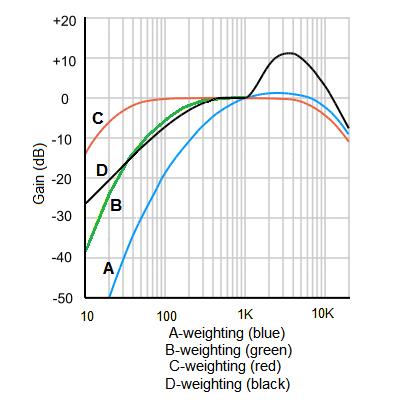
AV receiver (AVR) – a consumer electronics device for use with televisions and home theater systems, used to amplify sound from a variety of audio sources,such as DVD players, Blu-ray Disc players, VCRs, and video game consoles, as well as to route audio/video signals from these sources to the television or other displays. Many AVRs also include an AM/FM tuner. Sometimes called an audio receiver.
A-weighting – a method for measuring sound using an equalization curve with a response that simulates that of human hearing. A-weighting is based on the 40-phon equal-loudness curve developed by by Fletcher and Munson. It has been formalized in standards for sound level meters in IEC 60651, IEC 60804, IEC 61672, and ANSI S1.4. Also called A-filter or A-curve. See also B-weighting, C-weighting, D-weighting, K-weighting, and Z-weighting.
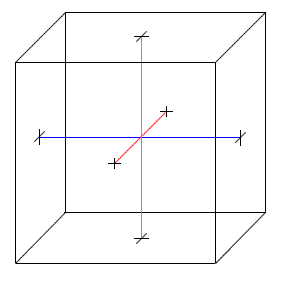
axe – slang term for a musical instrument, especially a guitar. Sometimes spelled ax.
axial mode – one of the three room modes in which resonance in a room is caused by sound reflecting between two parallel surfaces, such as front to back, side to side, or floor to ceiling. The other two modes are tangential mode and oblique mode.
axis – an imaginary line that runs straight through an object or figure. In the recording studio, this is most often applied to a microphone in the sense of an sound source being on-axis or off-axis. Plural is axes.
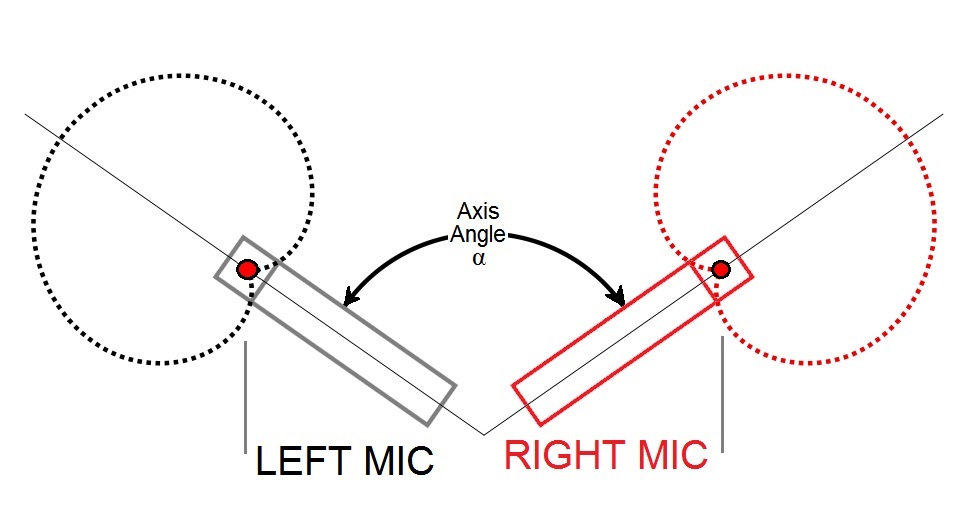
axis angle – the angle between the axes of two microphones used in stereo microphone techniques. The axis angle can be adjusted over a small range to change the relationship between the physical sound source positions in front of the microphones and their perceived positions in the stereo image, which is called the stereo recording angle, and should not be confused with the axis angle. Also called opening angle, mutual angle, offset angle, and receiving angle. Compare with acceptance angle, which applies to just one microphone.
azimuth – the angular relationship between the head gap and the tape path on a tape recorder.
azimuth alignment – see alignment.
azure noise – see blue noise.
Note: We believe this is the largest dictionary (glossary) of terms specific to usage within the recording industry that is currently available on the internet, with more than 8,800 entries, nearly 800 illustrations, and dozens of tables. Some of the terms have different or additional meanings in other situations, especially within the electronic, automotive, scientific, and computer industries. Of necessity there are obvious overlaps into other fields such as music, electronics, and computers, but such excursions are limited to information deemed pertinent to the knowledge required to operate and/or participate effectively in the workings of a recording studio. Also included are terms related to sound reinforcement (live performances) including wireless microphone technology because a working knowledge of that terminology is necessary for recording at live performance venues. Because recording studios also record audio for video and motion pictures (films), some terminology from those fields is included. Some scientific terms are included because they help explain studio terminology. For example, electromagnetism explains how microphones, loudspeakers, and guitar pickups work. Knowledge of radio waves and the radio frequency spectrum is needed to explain wireless devices. Any trademarks or trade names mentioned belong to their respective owners. The information contained in this dictionary is believed to be accurate at the time of publication. This information is subject to change without notice. The information was obtained from and cross-checked with a variety of sources that are believed to be reliable. However, Los Senderos Studio, LLC does not guarantee the accuracy or completeness of the information contained herein. Please contact us to report any errors, omissions, discrepancies, or broken links. Los Senderos Studio shall not be responsible for any consequences or damages arising out of the use of this information. Nothing in this glossary should be interpreted as legal advice. For a glossary providing information on legal and business matters for musicians, we suggest you consult Musicians Business Dictionary.
A note on alphabetical order: The terms in this glossary are alphabetical without regard to spaces and punctuation. For example, AM Radio follows amplitude. While this may seem to be at odds with other conventions, it eliminates confusion with words such as pickup, which is sometimes written as pick up or pick-up. In addition, all symbols such as &, -, or / are ignored. The entries on the number page (0-9) are listed in increasing value within each digit. For example, all of the entries beginning with 1 are listed before those starting with 2. For Greek letters (α-ω), the entries are in Greek alphabetical order.


